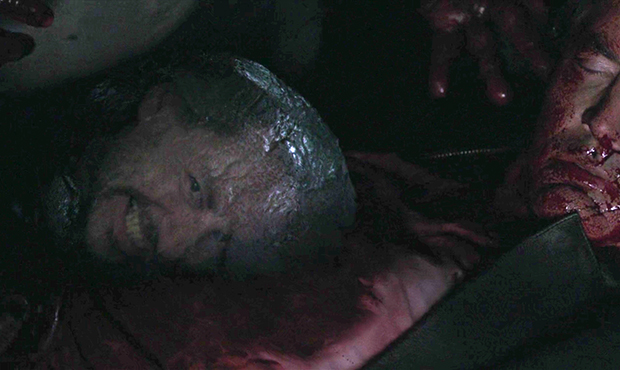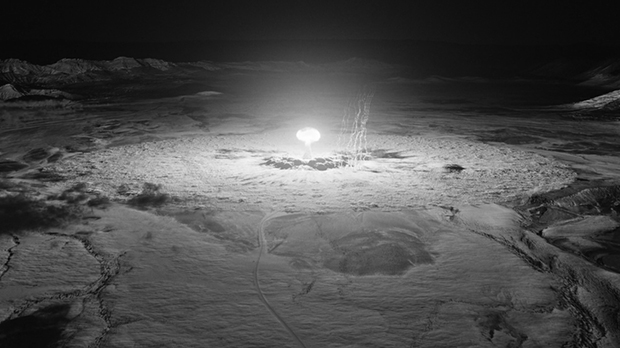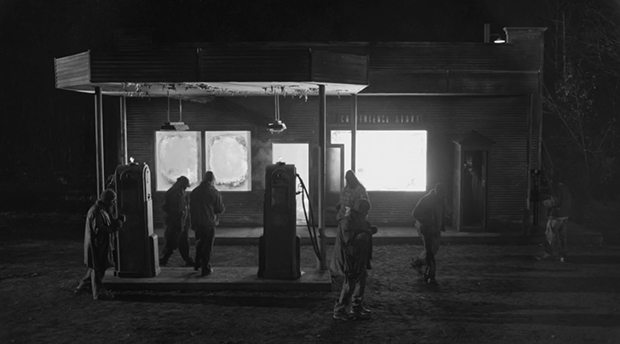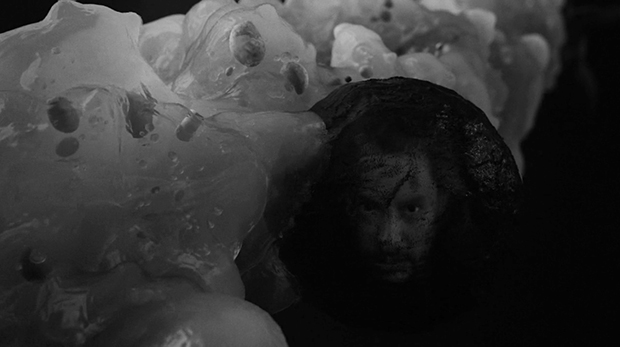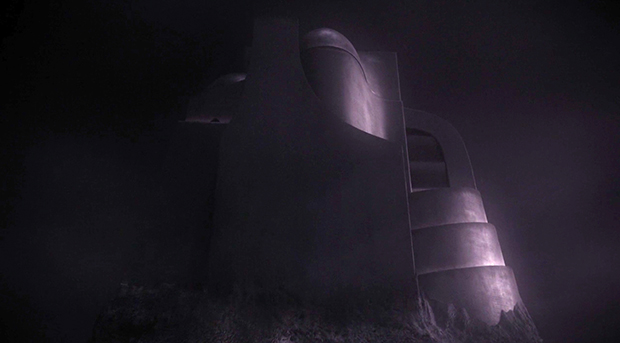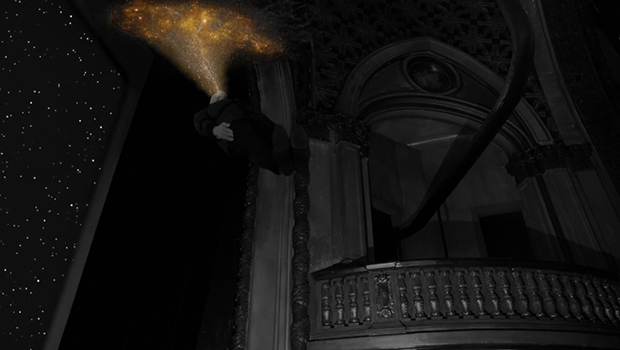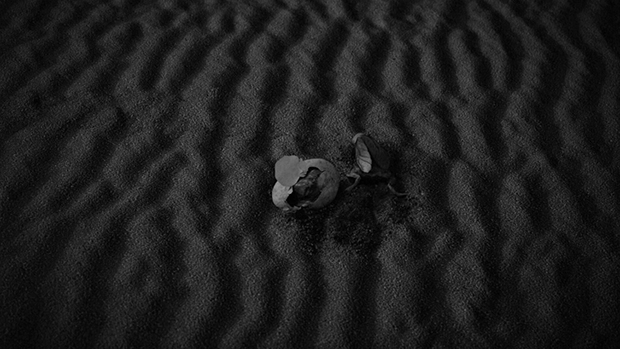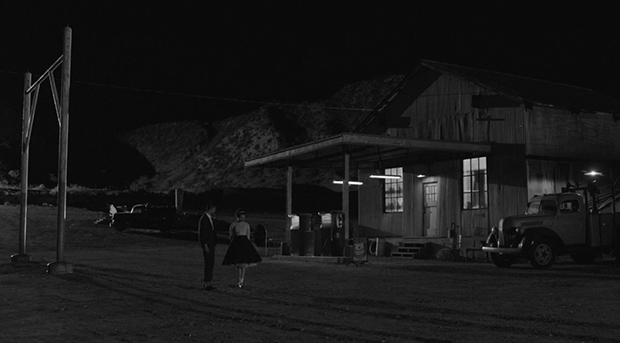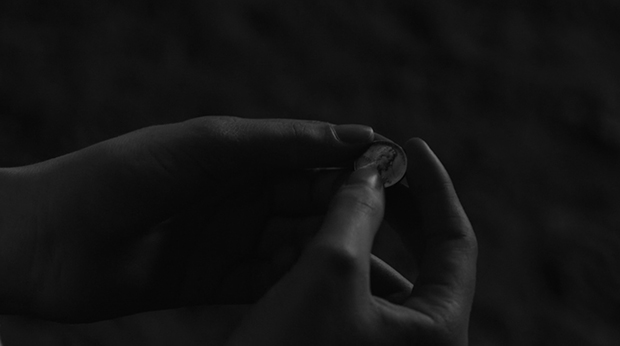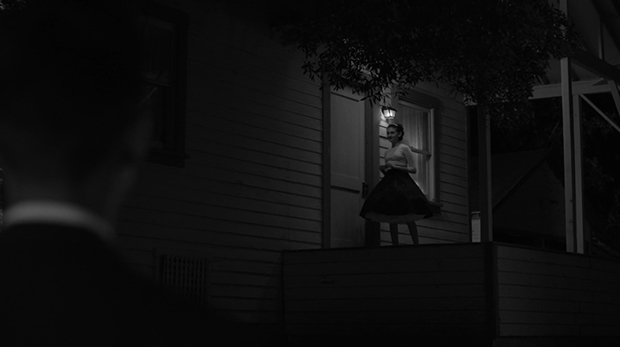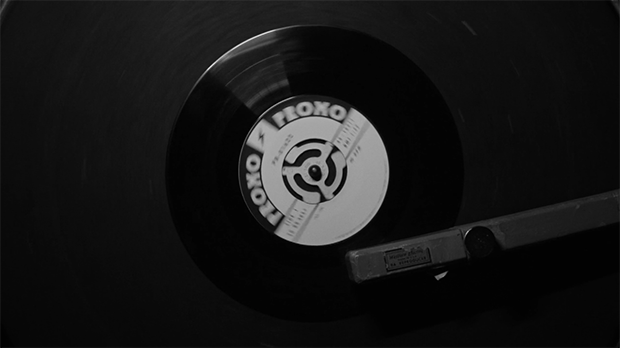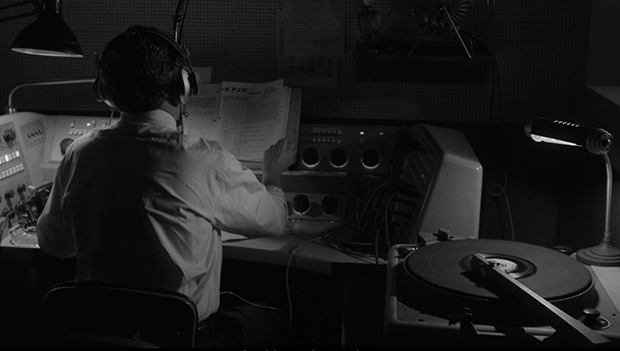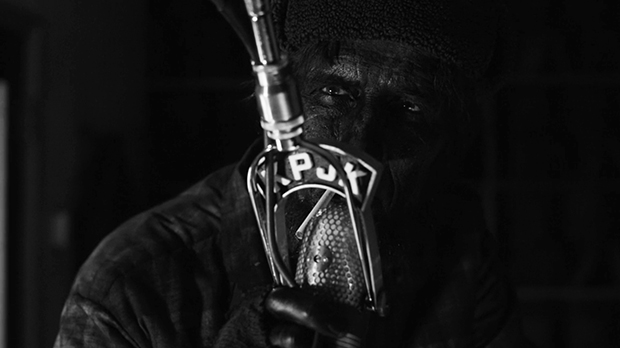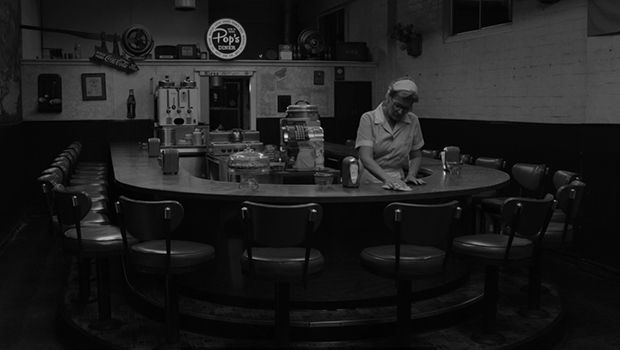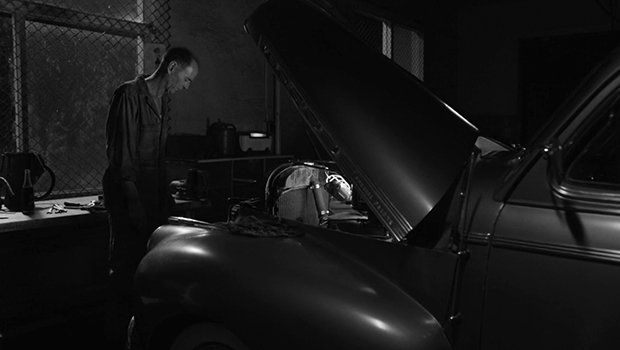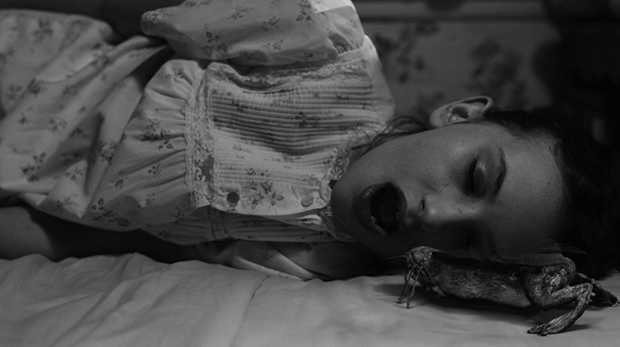TWIN PEAKS: THE RETURN

Go to Twin Peaks Table of Contents for a note on the analysis.
PART EIGHT
TOC and Supplemental Posts | Part 1 | Part 2 | Part 3 | Part 4 | Part 5 | Part 6 | Part 7 | Part 8 | Part 9 | Part 10 | Part 11 | Part 12 | Part 13 | Part 14 | Part 15 | Part 16 | Part 17 | Part 18 | Films Home
LINKS TO SECTIONS OF THE ANALYSIS ON THIS PAGE:
SPREAD THE INFECTION WHERE YOU SPILL YOUR SEED - Something I want / The degrading signs to the left and similarities to Cooper-Dougie's scribbles with the stepped wall / A symmetry with Cooper having been shot / The Nine Inch Nails Performance as a re-expression of what the woodsmen have just performed / Connections between the lyrics "spread the infection, where you spill your seed" to Blue Velvet and Dorothy speaking of Jeffrey's leaving his disease in her after sexual intercourse / Connection also to the child-creature in Eraserhead / Associations here to Jeffrey, the bug man, pave the way to other associations later in this eighth part / The mother in Blue Velvet and Eraserhead / What would the doppel be without BOB / Margaret's gum, Cooper, and his doppel
THE BIG FIRE - The birth of the nuclear age, July 16, 1945, 5:39 Am MWT / "Threnody for the Victims of Hiroshima" / The non-existent Naido and Hiroshima-Nagasaki as one of the possible reasons for the Asian theme / Trinity and Gordon and Eraserhead / From black and white to color / The frenzied particles of Eraserhead and the "stars" through which Cooper fell / The woman in the radiator as Trinity / The Manhattan Project and New York / The collision of black and white fire and the twin falls
THE CONVENIENCE STORE - The abstract black-and-white world of the bomb's after-effects seems to assume figurative form as the convenience store and the woodsmen / Fire Walk with Me, the convenience store, and the non-accidental intercourse between two worlds
THE EXPERIMENT BIRTHS BOB - Her arms bend back / The experiment as Mother birthing eggs and BOB / Comparison to Henry / Reviewing the congressman's dilemma / World-destroying time / The gold
THE JUPITEREAN REALM - The world of ??????? and Dido, where we first saw Cooper in part one, at the beginning of the series, is also to where he fell after passing through the glass box in Manhattan / The self-sacrificing, faithful Dido of myth / The emanation of the spirit of Laura in response to BOB / Maybe it's just Dido because dd is bb backwards / Dido's curse on Troy and Laura's pony, Troy
1956, THE BIRTH OF THE CREATURE - The creature in the desert and its relationship to a story David Lynch tells while cooking quinoa / The coins of Lynch's story and magic and metamorphosis / The lucky Lincoln coin found heads up / The swinging lamp / The boy and girl have a conversation that is a close replay of one between Sandy and Jeffrey in Blue Velvet / The suggestion of psychic ability...or not / "My Prayer", the Platters, and David Lynch / The KPJK radio station / The triskelion / Woodsman's hypnotic incantation / The sleeping collapse of the waitress, the mechanic, and the girl
ON THE ATOMIC AGE AND TWIN PEAKS
STAB AT A TIMELINE
SPREAD THE INFECTION WHERE YOU SPILL YOUR SEED
SOMETHING I WANT / THE DEGRADING SIGNS TO THE LEFT AND SIMILARITIES TO COOPER-DOUGIE'S SCRIBBLES WITH THE STEPPED WALL / A SYMMETRY WITH COOPER HAVING BEEN SHOT / THE NINE INCH NAILS PERFORMANCE AS A RE-EXPRESSION OF WHAT THE WOODSMEN HAVE JUST PERFORMED / CONNECTIONS BETWEEN THE LYRICS "SPREAD THE INFECTION, WHERE YOU SPILL YOUR SEED" TO BLUE VELVET AND DOROTHY SPEAKING OF JEFFREY'S LEAVING HIS DISEASE IN HER AFTER SEXUAL INTERCOURSE / CONNECTION ALSO TO THE CHILD-CREATURE IN ERASERHEAD / ASSOCIATIONS HERE TO JEFFREY, THE BUG MAN, PAVE THE WAY TO OTHER ASSOCIATIONS LATER IN THIS EIGHTH PART / THE MOTHER IN BLUE VELVET AND ERASERHEAD / WHAT WOULD THE DOPPEL BE WITHOUT BOB / MARGARET'S GUM, COOPER AND HIS DOPPEL
If we go by the timeline for the death of Ruth Davenport, it is Thursday, after 1 a.m. Perhaps September 29th 2016. (1) We see Mr. C and Ray in the car that Mr. C had arranged for them to travel in due his agreement with the warden. We know that there should be a gun in the glove compartment.
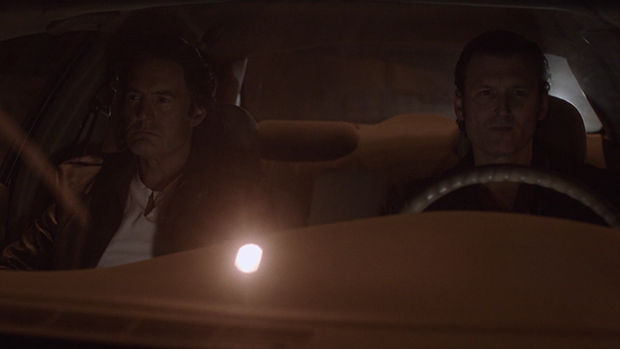
Mr. C and Ray
(2) Mr. C takes out a burner phone. He says, "There are three tracking devices on this car."
So many threes.
On the phone screen we see at top a black quadrangle with a C in the center. Then a black quadrangle with, in red, the word "Fire" and a blue triangle appended to the right of the quadrangle. Then at the bottom a black quadrangle at the center of which is a large circle with a dot in the middle, and a D to the left and an X to the right. An odd form of dox? To dox someone is to release their personal documents on the internet. (3-4) Mr. C appears to click these squares away and tells Ray to "get up close behind that truck" they are behind. (5-7) As they drive up behind it we see a license plate that reads DEGWW 8. (8) Mr. C types DEGWW into his keypad. As he types it in we see the phone offering anticipated spellings--DEFEAT to the left and DEGAS to the right. He finishes with DEGWW8 and the DEFEAT disappears and only DEGAS remains and is to the left.
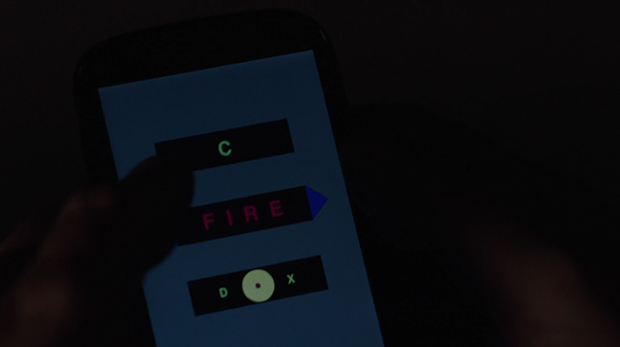
Phone
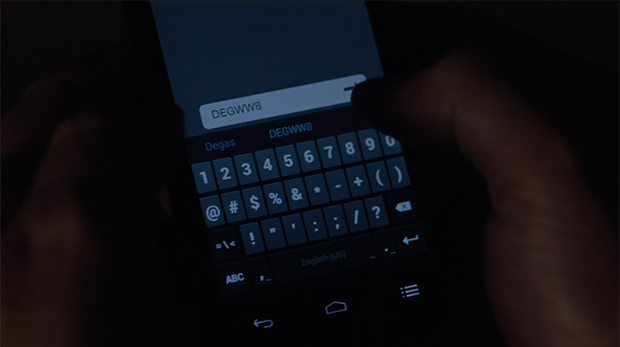
Phone
(9-14) "That should do it," he says and tosses the phone out the window.
Ray tells him, "I hope you're not sore at me for running off. It sure was stupid of me to get caught up like I did. Thanks for getting me out of there. How'd you do this?"
Mr. C replies, "Darya told me what happened. You needed to get out, Ray." Ray asks, "Where's Darya?" Mr. C tells him, "She's waiting for a phone call when we get someplace safe."
Ray asks, "Where are we going?" and Mr. C tells him, "You'd probably like to go to that place they call 'The Farm'." Ray replies that's what he was thinking, that they're "heading in the right direction. Just saying. They're not gonna let us just walk, are they? They're bound to be looking for us soon." Mr. C reminds him, "You have something I want." Ray says, "Yes, I do. I got it memorized. All the numbers. Memorized perfectly. But, honestly, Mr. Cooper, I think it might be worth some money. Maybe quite a lot of money." Mr. C says, "You do." To which Ray replies, "Yes sir, I do."
(15-17)
Mr. C says, "There it is. Take that little road up there on the right. Let's get off this highway, Ray."
The viewer knows that Darya is dead, that she was killed by Mr. C and that he knows Ray and Darya were hired, seemingly by Phillip Jeffries, to kill him. Or maybe not by Phillip Jeffries. After all, Mr. C thought he was going to be talking to Jeffries and it turned out not to be Jeffries that he was talking to, but it was someone with information on New York and Briggs and BOB. Who was it?
So maybe Ray and Darya have been in contact with Jeffries and maybe they haven't. Maybe they were in contact with someone impersonating Jeffires. We have no idea at this point.
Ray, for some reason, thinks he's right up there next to being lead dog like Mr. C. I don't have a clue why. Maybe because he's just not that bright. You don't fuck with Mr. C but Ray somehow thinks he can. He thinks he can shake some big money out of Mr. C. No doubt he has big money to be shaken down.
We have been shown the screen of Mr. C's phone and we assume this must be for a reason. What, if anything, can we gather from DEFEAT, DEGAS and DEGWW8. I can't think of anything. With "Degas" you could either have the painter or to de-gas something. We'd had the episodes earlier that formed a "gas" thread. We can wonder if there is something to be gained from comparing this all with DUGE LV on Dougie's license plate. I've got nothing.
(18) They take an exit, four yellow signs on it guiding them right, then one showing to curve left. We see a wall constructed of blocks so that it reminds of the stairs Cooper-Dougie had drawn on the insurance claim sheets for Bushnell. There are then two yellow signs with black bars pointing left, as we had seen with those pointing right, but the black bars in these signs are deteriorating, incompletely formed, the second one barely legible as a sign at all.
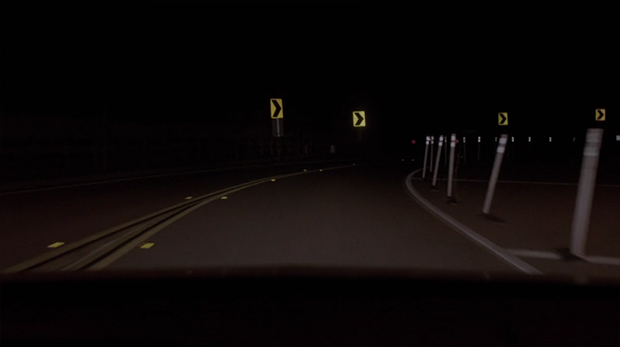
Signs
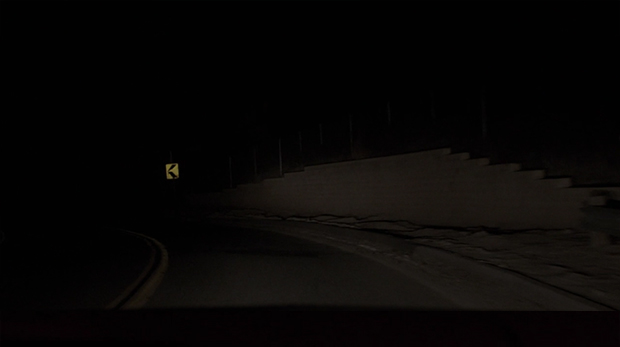
Signs
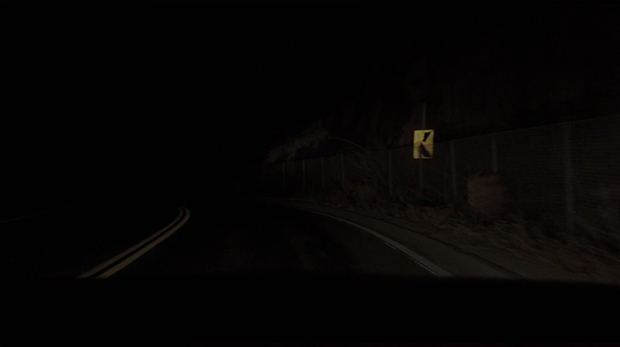
Signs
It seems meaningful that the right pointing signs are sharp and clear, but at the wall similar to Cooper-Dougie's drawings the left pointing signs are degraded, progressively worn away.
We've seen a similar stepped wall between the Rancho Rosa suburb sign and the long brick fence wall at the entrance.
(19) They continue driving and are turned on a (20) right curve by a white picket type fence. (21-23)
We hear they have driven onto a dirt road before we see it. Ray asks, "Do you mind if we pull over a sec? I gotta take a leak." Mr. C tells him, "Go for it.
(24) Ray parks, gets out and walks off. He not very noticeably reaches into a pocket as he does so. (25) Mr. C takes the gun from the glove compartment, checks to make sure it's loaded, (26-28) gets out and follows Ray. "I want that information," he tells Ray, and that it "looks like you're out half a million", which the viewer knows is the amount of money Ray was to be paid by Jeffries. (29-30) "I think you're wrong about that," Ray says, turning and holding a gun on Mr. C.
(31) Mr. C fires his gun but it only clicks. (32-34) "Tricked ya, fucker," Ray says and fires at him twice.
All these urgent needs to take a leak. Bobby's was coincident with the idea of the trails they didn't know about so they weren't seeing everything. Cooper's first was coincident with his looking in the mirror, his first morning in Las Vegas. The second time, his secretary had let him into the Ladies room, thinking the men's room was locked, and had made a play for him but he retained his innocence. Finally, Hawk is in the lavatory and he finds the pages of the diary in the bathroom stall, hidden behind the door's facade. He found them by means of the Indian Head coin that rolled over to the door with the Nez Perce Manufacturing sign--so I'm not certain that is a real door but more like a tulpa door like Dougie. Manufactured. The coin theme had partly begun with Red's doing his magic coin trick.
Now Ray has tricked Mr. C.
So, Ray had a gun on him. We wonder if the warden gave it to Ray. Ray's got, he believes, a reliable half-a-million coming at him from Jeffries, or whoever it is who hired him to kill Mr. C. He has no reason to not kill Mr. C. He believed he was lead dog with that gun in his pocket.
It's kind of a shock. We'd not expected Mr. C to bite it. We can't imagine, though, that he might not live. We remember how Cooper had survived being shot in the first series. We expect a showdown between Cooper and his doppel. This can't be the end.
(35) Mr. C falls. (36-38) Ray walks toward him to fire again, but (39-45) the dark is illumined with flashes of bluish light, (41) and dark, transparent figures start pouring out of the woods to Mr. C. The "woodsmen". One of these same figures we saw in a cell near Hastings in jail. Another had appeared at the morgue when the military, via Cindy Knox, was checking on Major Briggs, following his prints, and learned there was a body. (46-52 approx) The woodsmen surround the doppel and in pulsing light and dark they make mysterious movements around him, seeming to press their hands into his body, smearing him all over with blood, watching Ray as they do so. (53-60 approx) Ray falls to the ground, bewildered, horrified. A slowed-down track of Beethoven's "Moonlight Sonata" plays (Piano Sonata 14 in C# minor). (61) We are afforded the glimpse of a peculiar globe half-emergent from Mr. C's body, in which we see the face of BOB. The globe, here, in some ways reminds of an egg sac.
(62-66 approx) Ray rises, runs to the car and speeds away. The woodsmen continue their peculiar actions. Finally, they disappear. Fade to black. (67) Black clouds obscure the moon. (68-74 approx) In the car, Ray makes a phone call. "Phillip, it's Ray. I think he's dead. But he's found some kind of help so I'm not one hundred percent. I saw something in Cooper. It may be the key to what all this is about. I told him where I was going, so if he comes after me, I'll get him there."
The audience is all too aware that Ray will likely regret that he didn't shoot Mr. C with silver bullets, chop off his head, stuff it with garlic, and burn him. Even then, there's a strong possibility Mr. C would have revived to pursue him to The Farm.
In part seven, we had been reminded of Cooper's being shot as Ben referred to it when Beverly gave him the 315 key. We may even have the feeling that Cooper's having been shot is somehow connected with Mr. C's being shot, that there's a kind of symmetry to it all.
At the end of the first season, in episode eight (including the pilot as the first episode), Cooper had gone undercover at One-Eyed Jacks with Ed Hurley, and, as it turns out, Cooper is the sort who does well in a casino, which is perhaps not without relevance considering Cooper-Dougie's luck at the Silver Mustang.
Major Briggs is not the only one to have a peculiar item found in his stomach, Laura's autopsy had revealed part of a poker chip in her stomach, and while undercover at the casino/brothel, Cooper learned from Jacques that the chip was from when she was partying with him and Leo. Leo had forced her to bite on the poker chip, telling her, "Bite the bullet..." Then what happens when Cooper gets back to his hotel room from the casino/brothel? He "bites the bullet", shot three times. Season two opened with his lying on the floor after having been shot, during which time he has his vision of the giant. We later learn that the single bullet that struck Cooper was due his having lifted his bullet-proof vest in order to reach a tick. He rather magically recovers, exhibiting near superhuman strength, but the benevolent giant who had visited him during the night had assured him he would be all right.
If Cooper could survive that, we know Mr. C will survive this.
(75 etcetera--I'm not counting shots) Cut to the Roadhouse and the MC announcing the Nine Inch Nails. They play, "She's Gone Away", and something in their movements, the dark and light (usually the Roadhouse stage is well lit) and the milling of the crowd reminds of the Woodsmen that surrounded the doppel.
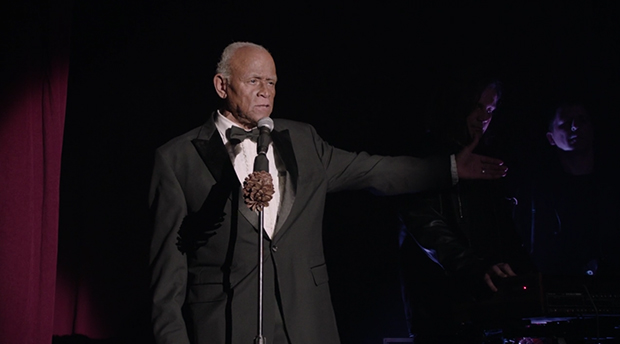
MC introducing 9 Inch Nails
Though the lyrics don't speak to this, it feels as if a rite of resurrection is being performed. That the doppel is dead but is being brought back.
You dig in places till your fingers bleed
Spread the infection, where you spill your seed
I can't remember what she came here for
I can't remember much of anything anymore
She's gone, she's gone, she's gone away
She's gone, she's gone, she's gone away
Away
Away
A little mouth opened up inside
Yeah, I was watching on the day she died
We keep licking while the skin turns black
Cut along the length, but you can't get the feeling back
She's gone, she's gone, she's gone away
She's gone, she's gone, she's gone away
She's gone, she's gone, she's gone away
She's gone, she's gone, she's gone away
Away
Away
Away
Away (Are you still here?)
nin.wiki states that in the 2016 Apple Music release there are unsung lyrics embedded that reference "Reptile".
you dig in places til your fingers bleed
she spreads herself wide open to let the insects in
spread the infection where you spill your seed
she leaves a trail of honey to show me where she's been
i can't remember what she came here for
i can't remember much of anything anymore
At the end of the above section, after Nine Inch Nails have finished with their song, the doppel sits up. He is alive. The audience is not confident whether he was healed or was actually dead and his life restored by the woodsmen. "Moonlight Sonata" was originally giben as Sonata quasi una fantasia, but a critic said it reminded him of the moonlight on Lake Lucerne, and the association stuck. Others objected as the music was more funereal than romantic. It was written for Giulietta Guicciardi, a piano student with whom he'd fallen in love, but her family was of a higher station and there was no question of their becoming married.
In Blue Velvet, what does Dorothy say when she and Jeffrey have sex, and later when she, out of her mind, goes to him, a shatteringly helpless nude form that emerges out of the bushes in front of his house. "I have your disease in me," she'd said when they had sex, but had also told him, when he left her apartment, that she still had a part of him in her and it made her stronger. Later, coming to him for help, "He put his disease in me," she had told Jeffrey's "good" girlfriend, Sandy, and Sandy thus became aware of their relationship. That Dorothy would seek help from a person she states has put his "disease" in her is disturbing, and that she would say it even proudly, possessive.
As I've related in earlier sections of the analysis, though Dorothy drew Jeffrey over to "the other side" in her apartment on the non-existent seventh floor on Lincoln Street, it was Sandy who had directed Jeffrey there. She had emerged, a near luminescent good girl figure, out of the dark, to tell Jeffrey what she knew about an investigation onto which Jeffrey had stumbled while in shock over his father's illness, finding a severed ear in a field. She had told him what she knew about Dorothy and led him to Lincoln Street to show him where Dorothy lived.
It was then Jeffrey got the idea of entering Dorothy's apartment as "the bug man", on the pretense of spraying it, so he may find a way to later surveil it. He steals a key of Dorothy's and returns at night when she is out singing, after having taken Sandy to see Dorothy perform. When Dorothy returns home he hides in a closet and watches her. In turn, when Dorothy finds Jeffrey in her closet, she commands him out of it and humiliates him. She has been abused by Frank. Now she abuses Jeffrey, as if intent on exposing the bad boy in him. The perverse Jeffrey. "You like to watch," she had said, and demands he move from being a watcher to a participant. When they have sex, she begs him to hit her. He says he doesn't want to, that he only wants to help her. But finally he does strike her and thus they too are bound by violence.
The same dynamic was had in Twin Peaks with Laura Palmer and her relationship with men. She was abused. She then abused. Jacoby explained to Bobby that she had abused him. She had abused Harold Smith.
We need to consider the idea of the "disease" and its relationship to not only sex but the artist and the viewer, for both are there. In Eraserhead, a thing like a strange, long, sperm-embryo hybrid emerges from the anxiety-ridden Henry's mouth. An act of creation, but it is one that is terrifying. It becomes the child that is his punishment for having sex. When he's told about the child by the mother of his girlfriend, she demanding to know if he'd had sex with her daughter, she attempts to seduce him then and there, not far from the presence of her daughter and husband, despite having raged at him about this child, which seems impossible to him that it should exist already, so suddenly, waiting for him down at the hospital. A ghastly thing, it is far removed from resembling anything human, but the viewer is inspired to feel sympathy for it in the same fashion that we feel sympathy and empathy for The Elephant Man, who is human and eloquently pleads for understanding. To condemn the Elephant Man as being monstrous makes monsters of us, and we feel the same queasiness with this infant creature that is anxiety, and breeds anxiety. It needs to eat but refuses to feed. Its constant cries, its longing, destroys its parents. At times, it even seems to laugh at Henry and his sexual temerity with a woman across the hall, who he wants but is afraid to approach. I have written previously of how, when the child is unwrapped, it is shown as not even possessing a body, only organs, and from these pours forth what becomes in Twin Peaks the garmonbozia, a food that is pain and suffering. The creature seems to not need food, therefore, because it is nurtured on the pain and suffering it causes. Before we are even shown, by means of one of Henry's dreams, that the child is him, we already sense that this demanding, horrifying bundle of anxieties is none other Henry.
The mother confusion occurs again in Blue Velvet, for when Dorothy appears, nude, stumbling out of the bushes, calling for Jeffrey, it's asked, at first, if she's Jeffrey's mother. Sandy's boyfriend, the jock, had intended to beat up Jeffrey for taking Sandy away from him, and had brought along his friends to support and help him. "I'm sorry, I didn't know," he instead says upon seeing Dorothy, thinking she's Jeffrey's mother. He flees as Dorothy, traumatized, zombie-like, twines herself about Jeffrey. Dorothy, seeking help, has bizarrely rescued Jeffrey from being beaten. But she is also a perplexity for the viewer as the abused woman, the one who receives the "disease" of the seed, who pronounces Jeffrey's seed as "diseased". We don't know if she is herself destructive or revealing something destructive in Jeffrey. Dorothy has a son who has been kidnapped by the psychopath Frank Booth, who demands Dorothy take the role of mother when he sexually abuses her. We understand that his kidnapping of the child is to control her, but psychologically it is as if he jealously removes the good son and takes his place as the perverse son. Unlike Eraserhead, the belongings of the child, in its room in Dorothy's apartment, speak of innocence. Peculiarly, there is no evidence of this child anywhere in Dorothy's apartment except for the room Jeffrey stumbles upon, and Dorothy orders him away from the child's things, as if his touch would taint them. The father of the boy, Dorothy's husband, had also been taken hostage by Frank, but he scarcely matters to the story. As a father and husband he is a non-presence. At the end of the film, when Jeffrey is observed in an idyllic, middle-class episode of men waiting for the meal that their women prepare for them, after seeing a cartoonish puppet of a stuffed robin devouring a bug, we finish with Dorothy at a park, restored, whole, reunited with her child, watching him play. But we wonder about the child, too, for when she was allowed by Frank to visit the kidnaped boy in a house of prostitution, as we heard her with the child in a separate room, we could tell that the child was hitting her. We heard her crying for him not to do so. No, no, no. As a viewer we think of the shock and abuses the uncomprehending child has suffered, separated from his mother. We imagine that he is taking out his rage on his mother. A child would question where his mother has been and why she hasn't rescued him, why she has abandoned him. Because of this, we may find it odd that Dorothy seems unconscious of the child's pain as belonging to him as a response to his experience and the desertion he feels. There is something in her cries of dismay that instead make her sound as if she now interprets the child as yet another abuser. At the end of the film, when we watch Dorothy reunited with her son, her life now a soft-focus glamour of flowers, trees, soft light and blue sky, despite her smile, we feel an odd disconnect with her son, whose face is never fully shown. Rather than peace, we may feel anxiety over the future, over what the child has experienced, over what will emerge later. We feel anxiety over dreamy innocence that is bound to be shattered again.
Jeffry's relationship with his own mother in Blue Velvet is nearly as non-existent as his relationship with his father. In the hospital, his father is given but a few seconds of speechless screen time. At home, Jeffrey's mother, who is presented as unwaveringly normal as any 1950s-1960s television mother, is a cheerful but not saccharine presence who is observed watching film noir movies on television. She is watching one when her husband falls ill. She is watching one with an aunt when Jeffrey goes out to take his walk that ends at Lincoln Street with Sandy. These movies that the mother watches act as synchronistic oracles. Jeffrey's father falls ill out on the lawn when there is a shooting in the movie the mother is watching. A person is stealthily climbing stairs in the movie she watches the night Jeffrey learns of Dorothy and her apartment building on the bad side of town. When he returns as the "bug man", he must take the exterior, fire escape stairs as the elevator is broken. Like Sandy, his mother also serves to introduce Jeffrey to the "other side".
Lynch/Frost have selected to have at this point, in part eight of The Return, a song in which infection is coupled with seed, and in unsung, released lyrics (post the filming of this scene) is also related to bugs, just as Jeffrey was the "bug man", and by the end of this part a horrifying bug will crawl into the story. Jeffrey may have entered Dorothy's apartment as an exterminator, but he is also the "bug man". To kill the bugs he must know them. He is as the bug, which also plays into Lynch forging connections to Kafka and his metamorphosis. Cooper, as the good FBI agent, must, like the exterminator, have an intimate understanding of those who are his "enemy".
In Lynch world, when the luminescent Sandy appears, she brings along with her the dark underworld of sex and trouble. She is the possible promise of love, of sex, of maybe even eventually a family, but is a door also to the underworld. When she learns of Jeffrey's plans to infiltrate Dorothy's apartment she wonders if he is just playing detective, or if he is perverse. He tells her that's for her to find out. By the time we reach Mulholland Drive and Twin Peaks, The Return, Lynch's representations of relationships have become more nuanced, but we are never certain, in these early works of Lynch, whether the woman is as an Eve/Lilith and is responsible for the fall of man, or if she simply exposes predilections that are already there. Jeffrey says he wants to help Dorothy, that he doesn't want to hurt her, but during sex she finally provokes him to strike her, and his later memory of this appears to pain him not only for his action but some pleasure he might have derived from it.
But it's not all about sex. With Henry, in Eraserhead, the sperm-fetus was already as him, a representation of all his anxieties feeding upon the anxieties it provoked. In Blue Velvet, Jeffrey is aligned with the viewer in the audience. They are Jeffrey, hiding in the closet, watching Dorothy's debasement on the stage. She also interacts with them via Jeffrey, when she finds him in her closet, drawing them out of their seat, demanding of them if they like to watch. When Jeffrey is forced to strip, the viewer is as well. What are their feelings? What do they wish to see? Why do they wish to see it? How do they really view Dorothy? Do they want the peep show, to see her humiliated? Does the viewer fill Dorothy with their infection? Does the artist? What is the real root of the violence that fuels the film-noir genre? Who put it there? Who is the fundamental source of the disease? Who is first cause?
All this needs to be considered in respect of BOB, Laura Palmer, Leland (Laura's father), and Detective Cooper, for these same dynamics are transferred over to them. The abused Laura, as with Dorothy, is confused as to her own badness and goodness. Does she want the evil? Is it part of her or not? Has she attracted this to her? Is it trying, as BOB, to take her over, to possess her? She uses others and takes pleasure in humiliating them as she has been humiliated, also viewing herself as exercising power, for she has come to view her sex as her power. Cooper, the Hardy Boys style detective, an innocent with mystic leanings, never meets Laura Palmer in the flesh, but through his investigation is drawn into the Red Room where she kisses him, a place in which he eventually confronts an evil doppelganger that supplants him and does everything that the good Coop would never imagine doing. Within the doppelganger is BOB, the same dark entity that had abused Laura, via her father, and had planned to possess Laura. When the doppel is shot, we see BOB housed in his torso as a kind of parasite encased in a vaguely reptilian shell or insectoid egg sac. As it is in his torso, is one to be reminded of mother and child? We have every reason to wonder what would the doppel be like if separated from BOB. What does Lynch conceive evil to be--is it part of human nature or distinct from it? From where does Lynch conceive of evil as originating? Would he have us believe that it is BOB that commits Leland's crimes and that when separated from BOB he is once again the good father? Would he have us believe that Leland has no control over his possession by BOB, who he professed to have met as a child, a neighbor who flicked matches at him and asked him if he wanted to play with fire.
In the introduction to episode eight of the original series, Margaret, the log lady, says, "I grew up in the woods. I understand many things because of the woods. Trees standing together, growing alongside one another, providing so much. I chew pitch gum. On the outside -- let's say, of the Ponderosa pine -- sometimes pitch oozes out. Runny pitch is no good to chew. Hard, brittle pitch is no good. But in between these exists a firm, slightly crusted pitch with such a flavor. This is the pitch I chew." In the case of Leland and some other Lynchian characters, compartmentalization of dark and light means almost no mixing and shades of gray. Thus the good father Leland is entirely unconscious of BOB and says he had "no idea", while his doppel cavorts in glee of evil. How are we to accept these extremes?
For that matter, does Lynch even have to know what he believes? Not that he needs to know. But an audience tends to expect their artists to have a firm grasp on their own beliefs. Without consciously acknowledging this, the audience doesn't expect to be put in a place of constant questioning of their beliefs without having a story tell them what to think in exchange. The manner in which Lynch/Frost unfold the story of Twin Peaks feeds a constant barrage of questions and reassessments, but no didactic belief structure.
THE BIG FIRE
THE BIRTH OF THE NUCLEAR AGE, JULY 16, 1945, 5:39 AM MWT / "THRENODY FOR THE VICTIMS OF HIROSHIMA" / THE NON-EXISTENT NAIDO AND HIROSHIMA-NAGASAKI AS ONE OF THE POSSIBLE REASONS FOR THE ASIAN THEME / TRINITY AND GORDON AND ERASERHEAD / FROM BLACK AND WHITE TO COLOR / THE FRENZIED PARTICLES OF ERASERHEAD AND THE "STARS" THROUGH WHICH COOPER FELL / THE WOMAN IN THE RADIATOR AS TRINITY / THE MANHATTAN PROJECT AND NEW YORK / THE COLLISION OF BLACK AND WHITE FIRE AND THE TWIN FALLS
Having seen the doppel restored, we are now shown a great desert in black-and-white. It's July 16, 1945. 5:39 AM MWT. White Sands, New Mexico. The Trinity bomb is about to go off and The Nuclear Age begin. David Lynch's mother is about 3 months pregnant with him. He is one of the first children of The Nuclear Age.
We hear a countdown. There is a blinding flash of light. Penderecki's, "Threnody for the Victims of Hiroshima" (also originally titled "8:37") begins, because of the bombs dropped on Hiroshima-Nagasaki, and we should hear horror even as we marvel at the glorious, appalling radiance of the bomb. And it occurs to me that West meeting East in Lynch's The Return possibly has everything to do with WWII and Hiroshima and Nagasaki. The landscape looks nearly alien after the initial flash, the bomb continuing to illuminate with its fire, driving away the night, time having slowed to a near stop as the mushroom cloud of the bomb rises. The camera zooms in on its blossoming cauliflower head, entering.
Lynch/Frost have been preparing the audience, in the first seven parts, for this one, how it plays with time, its long stretches without dialogue, mysteries presented and no explanations offered.
That this atomic bomb blast follows after the shooting of the doppel is because they are related. One may wonder why we were shown BOB partly-emergent from the doppel's chest, as these eerie woodsmen worked feverishly on him, especially as we are already aware that BOB is a part of the doppel. The reason becomes clearer when we eventually are shown BOB somehow emerging from the bomb blast. We are supposed to mark a comparison.
We have already observed a large photo of the Trinity blast on Gordon's wall in his office. In Eraserhead, Henry had an image of the Trinity blast beside his bed, above Eraserhead's version of The Tree as The Arm, a small barren sapling stuck in a pile of earth on a bedside table. These are long enduring symbols for Lynch. Henry's hairstyle in Eraserhead may even remind of a mushroom blast in the way it stands atop his head in a style bizarre for the time.
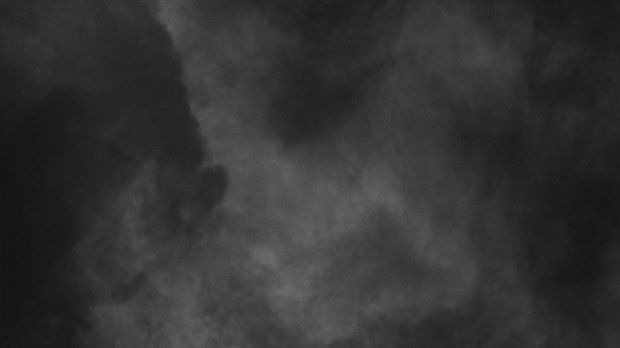
Moving inside the mushroom cloud
As soon as we enter the cloud of dust, debris and radioactive particles, we move from shades of gray to a harsh high contrast of black, white and blue separating from and blooming within each other, then to a cloud of orange dust and light overtaking the screen.
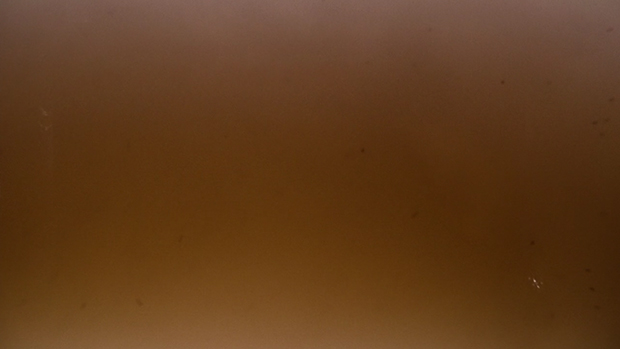
Transitional orange phase
Everything is then a sea of black behind a frenzied dance of white particles that continue to pick up speed until they are streams of light rather than dots. We should be reminded of Henry, in Eraserhead, when his brain is used as an eraser and its particles, as well as those particles of what it has erased, are blown away off a desk. Or when a planetoid object partially explodes toward film's end, its dust surrounding his head, and he later seems by this to be able to enter a paradise where waits for him the Woman in the Radiator who had, in an earlier dance, squashed things, like that which had emerged from his mouth, under her feet. These particulates are to be compared to the sea of stars through which Cooper falls when he tumbles out of the Red Room, first landing in the glass box in New York, and then in the balcony above the purple sea.
The Woman in the Radiator in Eraserhead seems to me to be related to the radioactive properties of the bomb. Indeed, if we examine her--her protruding cheeks, her hair--we see that she is in fact a representation of the mushroom head of the cloud. When she and Henry touch, he experiences a bewildering illumination. It is in response to this touch, after the woman is replaced with a barren small tree rolled out on stage (the smaller sapling by his bed was in front of the photo of the Trinity cloud), that Henry steps anxiously into a kind of dock and what amounts to a penis pops up from Henry's neck, thrusting Henry's head from off his body. The tree begins to profusely "bleed" from its base, and the child's head replaces the penis, emerging then from Henry's neck. Henry has four options presented for a sex or love partner in the film. There is the sultry woman across the hall from him, who he desires but he never approaches her. His girlfriend's mother makes a move on him, which of course petrifies him. He appears to confess having had sex with his girlfriend, and insists he "loves" her, which would make that sex "OK", but we're unconvinced of that love, and their marriage immediately falls apart. The Woman in the Radiator makes her appearance, delightedly stomping upon these same sperm-fetus hybrid creatures, one of which had doomed Henry to marriage and fatherhood. With this spiritual creature, we sense there will be no worries of propagation. She sings of the promises of heaven, just "good things" and everything being all right. The film ends with this spirit pair embracing in light, she always a representation of bliss--though this the Woman in the Radiator quite likely represents the radiation of the bomb, of Trinity--and though he accepts her (may even desire this end), his expression is, as ever, lost.
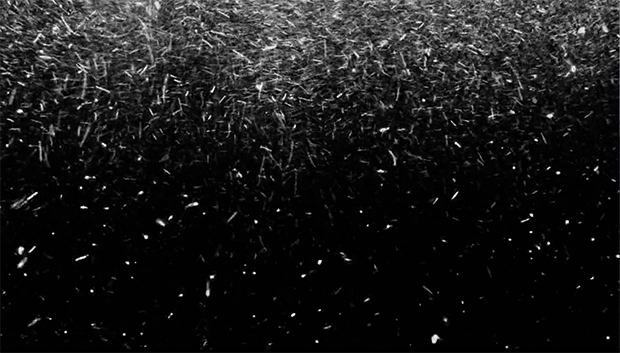
Particles picking up speed in movement
Again we have the orange screen of dust, then again the particles that seem also, with the frenzied music, as masses of storming bugs.
The screen, a la Kubrick and 2001, explodes then with color, reddish pinks, oranges, yellows, as if galaxies birthed from the bomb, but there is also an intestinal sensibility to them, the manner in which the camera tunnels through them, so at times one may wonder if we are inside the doppel's stomach and viewing the damage of the bullet expanded in time.
Trinity was part of the Manhattan Project, and we need to consider how this may be expressed in New York and the glass box in which The Experiment appears, and also Cooper. He falls through starry particles, like this, into the box, then the box multiples numerous times within itself and he is ejected and finds himself falling again.
Red fire overtakes the screen, followed by black and white fire that becomes two colliding pillars that are swept up in each other, not too unlike the colliding twin falls of Twin Peaks that clash and reunite in the river below.
THE CONVENIENCE STORE
THE ABSTRACT BLACK AND WHITE WORLD OF THE BOMB'S AFTER-EFFECTS SEEMS TO ASSUME FIGURATIVE FORM AS THE CONVENIENCE STORE AND THE WOODSMEN / FIRE WALK WITH ME, THE CONVENIENCE STORE, AND THE NON-ACCIDENTAL INTERCOURSE BETWEEN TWO WORLDS
A dramatic shift immediately occurs after the meeting of these two pillars, the viewer abruptly leaving these often abstract images and being shown a scene of a dark convenience store in black and white. Bursts of light from within the store are observed, then emerge outside as cloudy smoke. The intensity of the light bursts with the store increasing, in the light and dark we see a number of the woodsmen. The music degenerates to static, and the stuttering movements of the figures seems almost a re-interpretation of the earlier particles, rephrased in humanoid form, in a human place.
Convenience means harmony, agreement from com, with, and venire, to come.
They lived above a convenience store--that is what the spirit, Mike, told Cooper, of himself and BOB and others. In Fire Walk with Me, we were afforded a view of its surreal nature and had the first glimpse of woodsmen, then only bearded and mute, not yet covered with the residue of oil or smoke. Not this black and white world. There is no "above" here, and so I am reminded of the purported seventh floor of Dorothy's apartment building Blue Velvet, which, upon examination, isn't there, the building having only six floors.
Script dialogue not included in FIre Walk with Me brings in the world of the quantum jumpers, atomic exchanges between worlds, which it seems to me we may observe here with the black-and-white particles and then the woodsmen:
FIRST WOODSMAN (subtitled): We have descended from pure air.
MAN FROM ANOTHER PLACE (subtitled): Going up and down. Intercourse between the two worlds.
BOB (subtitled): Light of new discoveries.
MRS. TREMOND (subtitled): Why not be composed of materials and combinations of atoms?
MRS. TREMOND'S GRANDSON (subtitled): This is no accident.
MAN FROM ANOTHER PLACE (subtitled): This is a Formica table. Green is its color.
FIRST WOODSMAN (subtitled): Our world.
MAN FROM ANOTHER PLACE (subtitled): With chrome. And everything will proceed cyclically.
SECOND WOODSMAN (subtitled): Boneless.
MIKE (subtitled): Yes, find the middle place.
BOB (subtitled): I have the fury of my momentum. Green is its color. Our world. With chrome.
The above does confirm that Lynch/Frost are thinking in terms of spirits that have come from another realm and found expression in the world of matter. But the bomb does not open the Twin Peaks world to an alterate realm. Even before Trinity and 1945, the Twin Peaks area had a gateway to another realm, as spoken about on the show and revealed further in The Secret History of Twin Peaks.
Still, Lynch is here making Trinity and the birth of the Nuclear Age an important event, and symbol, and metaphor, that has all to do with a coalescence of a BOB style of evil and the woodsmen as its henchmen. There's some etymological correlation of the "going up and down" with BOB through "bob" as a verb, meaning, to move up and down with a short, jerking motion, perhaps from a word meaning to beat, cheat, deceive.
To understand how Lynch and Frost use the bomb, in its relationship to evil, we might have to go back to other mythological disaster stories, such as Sodom and Gomorra, which is equated with evil, but that overturn having to do instead with its destruction rather than its birth. There have been many legendary stories of humans being destroyed because of the evil they generate, but Lynch/Frost instead have made this a birth of evil story.
Lot's wife, of the Sodom and Gomorra story, turned around to look back and became stone. There have been a lot of "stone" faces in Twin Peaks: The Return.
This convenience store is staged so that we might think of it as solidifying in the Trinity desert after the explosion.
The use of the convenience store has always been interesting to me, as convenience stores, as are popularly known, were a fairly late mid-century development. But if we look up the store that birthed the 7/11, we find that it was in 1946 it first adopted these hours and changed its name to reflect this. Still it was a Texan franchise and wouldn't spread out until later.
Perhaps part of the point about the "convenience" store is the amassing, the coming together of these forces that have materialized out of the air, through the intercourse between two worlds. Whatever, they materialize, finding expression as the woodsmen who are like oily, dark angels.
THE EXPERIMENT BIRTHS BOB
HER ARMS BEND BACK / THE EXPERIMENT AS MOTHER BIRTHING EGGS AND BOB / COMPARISION TO HENRY / REVIEWING THE CONGRESSMAN'S DILEMMA / WORLD-DESTROYING TIME / THE GOLD
Another transition. We briefly see the outer edges of a whorl. There is blackness. Then in the blackness a figure appears who is the Experiment that attacked Sam and Tracey in New York, only envisioned to be slightly different, with small horns on the head, and at least one of the arms is bent back. Out of the creature's mouth is vomited a black-and white plasma filled with egg-like objects. In the midst of these we see a spheroid in which the face of BOB appears.
In the historical imagery of the demonic, the horns on the Experiment seem to further identify her as evil.
The manner in which she spews these eggs and BOB from her mouth, could be seen as even a replay of the Trinity explosion, only represented in a different manner.
Once again, we are returned to Henry, at the beginning of Eraserhead, and the sperm-fetus hybrid of a creature that is expelled from his mouth, which becomes his child and is pure anxiety. The plasma also seems another interpretation of the bomb.
And the bent back arms? They of course are intended to remind us of when Laura Palmer tells Cooper, in the Red Room, she feels like she knows Laura, but sometimes her arms bend back. I have earlier in the analysis linked this with the puzzle laid out for us in part three, the first part of the puzzle being a photo of a woman in a bikini, followed by pliers, a photo of two other women in bikinis, a photo of a boy in a sailor suit, a gun, and the bottle of Great Northern White Beans. I'll not go into that again here other than to say that I had related the women in the bikinis to the bomb, the name "bikini" taken from the nuclear testing at Bikini Atoll. I had related also the first image to the triskelion, though not quite it yet, only becoming triskelion through the idea had in the pliers meaning to bend, twist, thus the second image of not one but two women, their arms in a different direction from the first photo, and wearing sunglasses, as if against the light of the bikini bomb. The triskelion is none other than Trinity. As I wrote in part three:
Oppenheimer named the blast "Trinity" in reference to John Donne's "Batter my heart, three-person'd God" from his Holy Sonnets.Batter my heart, three-person'd God, for you
As yet but knock, breathe, shine, and seek to mend;
That I may rise and stand, o'erthrow me, and bend
Your force to break, blow, burn, and make me new.
I, like an usurp'd town to another due,
Labor to admit you, but oh, to no end;
Reason, your viceroy in me, me should defend,
But is captiv'd, and proves weak or untrue.
Yet dearly I love you, and would be lov'd fain,
But am betroth'd unto your enemy;
Divorce me, untie or break that knot again,
Take me to you, imprison me, for I,
Except you enthrall me, never shall be free,
Nor ever chaste, except you ravish me.
Oppenheimer also drew quotes from the Bhagavad-Gita in his thinking on the bomb. From Wired:
Oppenheimer, watching the fireball of the Trinity nuclear test, turned to Hinduism. While he never became a Hindu in the devotional sense, Oppenheimer found it a useful philosophy to structure his life around. "He was obviously very attracted to this philosophy," says Rev Dr Stephen Thompson, who holds a PhD in Sanskrit grammar and is currently reading a DPhil at Oxford University on other aspects of the language and Hindu faith. Oppenheimer's interest in Hinduism was about more than a soundbite, it was a way of making sense of his actions.
The Bhagavad-Gita is 700-verse Hindu scripture, written in Sanskrit, that centres on a dialogue between a great warrior prince called Arjuna and his charioteer Lord Krishna, an incarnation of Vishnu. Facing an opposing army containing his friends and relatives, Arjuna is torn. But Krishna teaches him about a higher philosophy that will enable him to carry out his duties as a warrior irrespective of his personal concerns. This is known as the dharma, or holy duty. It is one of the four key lessons of the Bhagavad-Gita: desire or lust; wealth; the desire for righteousness or dharma; and the final state of total liberation, or moksha.
Seeking his counsel, Arjuna asks Krishna to reveal his universal form. Krishna obliges, and in verse twelve of the Gita he manifests as a sublime, terrifying being of many mouths and eyes. It is this moment that entered Oppenheimer's mind in July 1945. "If the radiance of a thousand suns were to burst at once into the sky, that would be like the splendour of the mighty one," was Oppenheimer's translation of that moment in the desert of New Mexico.
In Hinduism, which has a non-linear concept of time, the great god is not only involved in the creation, but also the dissolution. In verse thirty-two, Krishna speaks the line brought to global attention by Oppenheimer. "The quotation 'Now I am become death, the destroyer of worlds', is literally the world-destroying time," explains Thompson, adding that Oppenheimer's Sanskrit teacher chose to translate "world-destroying time" as "death", a common interpretation. Its meaning is simple: irrespective of what Arjuna does, everything is in the hands of the divine.
"Arjuna is a soldier, he has a duty to fight. Krishna not Arjuna will determine who lives and who dies and Arjuna should neither mourn nor rejoice over what fate has in store, but should be sublimely unattached to such results," says Thompson. "And ultimately the most important thing is he should be devoted to Krishna. His faith will save Arjuna's soul." But Oppenheimer, seemingly, was never able to achieve this peace. "In some sort of crude sense which no vulgarity, no humour, no overstatements can quite extinguish," he said two years after the Trinity explosion, "the physicists have known sin; and this is a knowledge which they cannot lose."
No doubt, many things are represented in the images of Trinity we saw first in Eraserhead and which overwhelms Gordon Cole's office in Twin Peaks. Artistic and mystical reveries on quantum mechanics are certainly there.
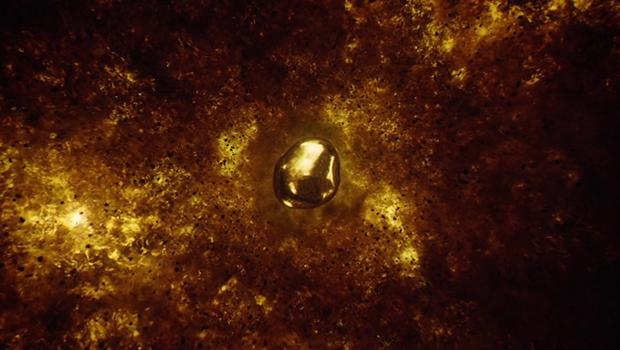
Gold ball out of fire
The camera zooms in on the plasma effluence and then we move from black-and-white to another eruption of golden bursts of fire, out of which a golden globule materializes, perhaps of the alchemical type, in which the fire is reflected. Then to the camera zooming through small globules as of red blood, and finally the purple sea that we may recognize from part three, but the waters are now active and roiling rather than placid.
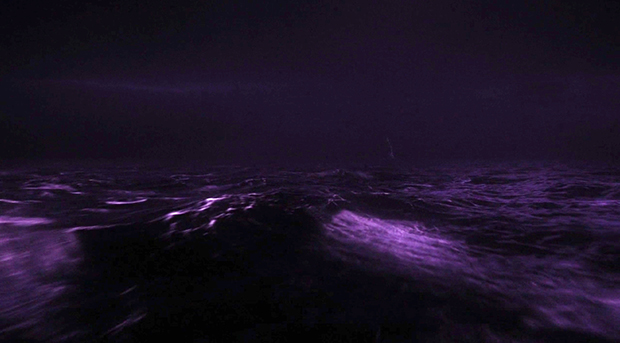
Purple sea
That gold does eventually coalesce seems to represent that a balance does emerge, or the capability for it.
THE JUPITEREAN REALM
THE WORLD OF ??????? AND DIDO, WHERE WE FIRST SAW COOPER IN PART ONE, AT THE BEGINNING OF THE SERIES, IS ALSO TO WHERE HE FELL AFTER PASSING THROUGH THE GLASS BOX IN MANHATTAN / THE SELF-SACRIFICING FAITHFUL DIDO OF MYTH / THE EMANATION OF THE SPIRIT OF LAURA IN RESPONSE TO BOB / MAYBE IT'S JUST DIDO BECAUSE dd IS bb BACKWARDS / DIDO'S CURSE ON TROY AND LAURA'S PONY, TROY
Zoom in on an island of rock and atop this a building of an unimaginable, enormous size, made out of a material that resembles the building and its balcony onto which Cooper dropped.
As the camera zooms in, a long rectangular window or door comes into view. We pass through it.
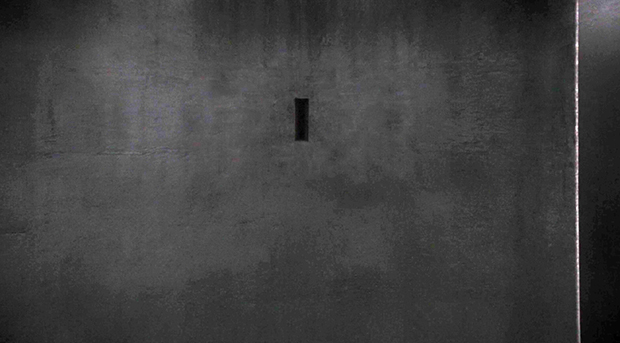
Door
Zooming in through this door, we leave the world of color and enter again one of black-and-white. By way of its gramophone, we see we have returned to the room of Part One in which Cooper had his interview with ??????? A woman listens to music. Her outfit seems a combination of silent film era style and early mid century sci fi. Senorita Dido. To me, there is something about her that strongly resembles Audrey Horne.
Now, we are able to clearly see the room's carpet and that it features a repeated pattern highly reminiscent of the anticyclonic eye of the Jupiter Red Storm that was first observed about 1665. So, this would be Jupiter, whereas the Red Room is aligned with Saturn, as we well know from its Saturn-light. This same carpet was also seen in the room of Part Three in which Cooper encountered first Naido, and then the American Girl. When Naido had led Cooper up a ladder and out onto the improbable box in which was housed this universe, she had switched off the power of a dome situated atop it. We see the same dome, or one near identical to it, but with what look like two high voltage terminals at the top. A banging comes from within it, which is perhaps intended to remind us of the banging when Cooper was with Naido and the American Girl.
??????? appears from behind the generator/transformer, examining it as we hear the knocks. We see flashes of light above the dome.
Why Senorita Dido? Dido, also known as Elissa, was the founder and first queen of Carthage and there are varying, conflicting myths about her. She, and Pygmalion were children of a king of Tyre. Upon the king's death, Dido married Acerbas, a priest of Hercules. He hid his riches away in the earth from the grasping Pygmalion. When Pygmalion had him murdered, in order to attain these riches, Dido escaped with his gold to what would become Carthage. A priest of Jupiter accompanied her there, so we are certainly intended to look to her myth. Her occupation took up as much land as it did through her stating she would only require as much land as could be encompassed by an oxhide, then cutting up the oxhide into strips and using these to encircle a full hill. One story has Dido sacrificing herself on a funeral pyre rather than marrying a King Iarbas, who had said he would declare war on Carthage if she did not agree to become his wife. In this manner she also maintained faithfulness to her first husband. Other accounts have her as becoming a lover of Aeneas, but in his jealousy Iarbas caused Aeneas to leave her. Also, Jupiter wanted Aeneas to get on his way to the defense of Troy. Enraged, yet also feeling guilty about her first husband, Dido curses Aeneas to fail in the Trojan War and that her people and his would be enemies. Dido, aided by her sister, Anna, builds a funeral pyre, and kills herself upon it, joining her her first husband in Hades. The fire was great enough that it could be observed by ships at sea.
Though Dido was accompanied by a priest of Jupiter, it has been written by Plutarch and horrified others that children were burned at Carthage to propitiate Saturn or Cronus.
Dido seems to represent faithfulness, whereas the beautiful Helen, said to be the cause of the Trojan War, either fell in love with Paris and left her husband willingly to go with him to Troy, or was taken by him. What she didn't do was kill herself. Dido, the faithful, dies but wins. Troy is destroyed.
None of this exactly answers the "why" of Dido, but there has been the theme of faithless women and men betraying husbands and wives so one might wonder if that is at play.
The giant seems to click a button on the generator and the noises stop. He leaves the room and is next observed ascending a long staircase.
He enters what looks to be an old theater/cinema, carpeted with the Jupiter pattern. We see in it another of the domes. He approaches the silver screen and raises his hand. We see the Trinity blast. This time, looking at the blast, we cut from entering its mushroom cloud to the woodsman figures skittering around the convenience store.
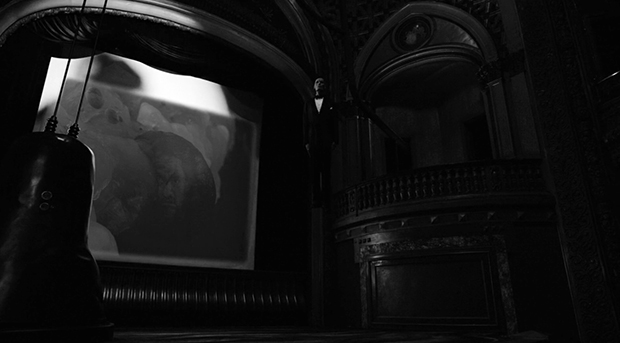
Bob on the screen
We see the plasma effluence from the Experiment, and the sphere in which BOB's face appears. ???????, at this point, pauses the play on the screen. He turns away from the screen, and appearing to meditate, rises up into the air, this accompanied by organ music. A spotlight shines upon Dido and tracks with her as she enters the room to watch the floating ???????
The earlier representation of the appearance of the gold, as if to counter evil, is reframed with ?????? becoming a source of the gold. In answer to the BOB sphere emanated by the Mother Experiment, he produces a golden sphere that contains what will become Laura.
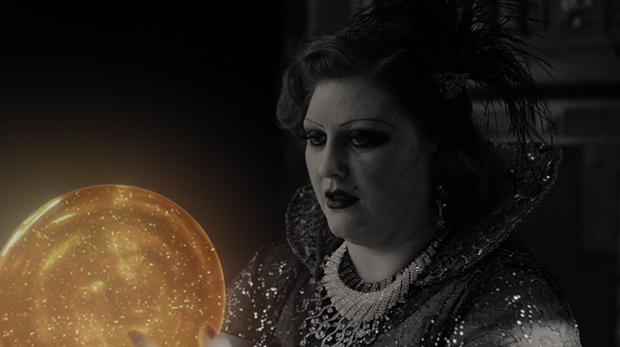
Dido and the golden sphere
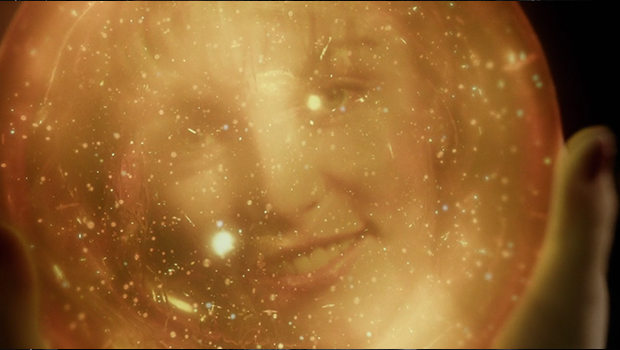
Laura
To the viewer, Laura appears to be the answer to the evil now showering the earth, or at least the answer to BOB, the answer to the bomb. Dido kisses the sphere, as if blessing it, then she releases the sphere and it floats up to a curling gold horn that also resembles an ear trumpet. The gold sphere enters through where breath would leave the horn, passes through the trumpet that is between two gold UFO-like objects (beyond which we see something like the clockwork of the universe?) and exits through that part into which air would be blown.
There is definitely a Glenda, the Good Witch, vibe to that sphere.
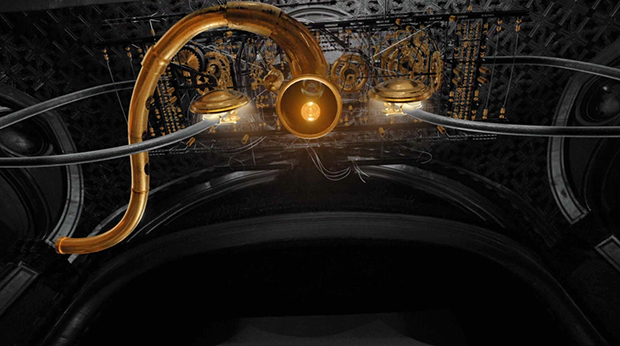
The sphere floats up into the horn

The sphere descends to earth
Laura's sphere enters the silver screen, the black-and-white world, and lands in America. Her potentiality precedes her birth by some 26 years, occurring at the time of the Trinity explosion, in response to it. Now we might feel like Laura should have had a bigger role in the story, as she is a supernatural response to BOB formulated years before her birth. We feel like, with this origin story, she shouldn't have ended up such a mess and killed by Leland/BOB. WTH? She was supposed to be the golden answer to BOB. Maybe she will end up having a bigger role in the story? But maybe Laura as a balancing response to BOB has less to do with her own actions and more to do with how she effects the world and what others do in response to this, such as Cooper ending up in Twin Peaks because of her murder.
Perhaps DIDO, who kisses Laura's sphere, or breathes into it, is the name chosen for this role as she could represent an opposition to BOB, dd being bb in reverse. But on her 12th birthday, Laura received not only her diary, but her pony, which she later let loose and as it was neglected it had to be euthanized. She named that pony Troy, and so we have the possible germ of Dido already there.
Jupiter was present in Laura's cat, who she named Jupiter. It was run over by a car.
Really bad shit can happen to you when you're the hope of the world.
1956, THE BIRTH OF THE CREATURE
THE CREATURE IN THE DESERT AND ITS RELATIONSHIP TO A STORY DAVID LYNCH TELLS WHILE COOKING QUINOA / THE COINS OF LYNCH'S STORY AND MAGIC AND METAMORPHOSIS / THE LUCKY LINCOLN COIN FOUND HEADS UP / THE SWINGING LAMP / THE BOY AND GIRL HAVE A CONVERSATION THAT IS A CLOSE REPLAY OF ONE BETWEEN SANDY AND JEFFREY IN BLUE VELVET / THE SUGGESTION OF PSYCHIC ABILITY...OR NOT / MY PRAYER, THE PLATTERS, AND DAVID LYNCH / THE KPJK RADIO STATION / THE TRISKELION / THE WOODSMAN'S HYPNOTIC INCANTATION / THE SLEEPING COLLAPSE OF THE WAITRESS, THE MECHANIC, AND THE GIRL AND A SENSE OF RELATIONSHIP TO NORMA AND ED
The story switches, the clock ticking from 1945 to 1956, August 5, a New Mexico Desert. We are still in Trinity land.
We see lying amidst the sands one of the eggs that had originated from the Experiment. It cracks open and a creature that is a seeming combination of insect and amphibian emerges. It strikes me as perhaps resembling a cicada.
Now to a story Lynch tells while cooking quinoa, which he describes as being like sand.
Thinking of all those little quinoas, bubbling away, in that pan, and we're looking at about two minutes more before we have the broccoli (shows the time 7:41) I'll tell the story of going from Athens, Greece, back up to Paris, but this story takes place after leaving the country of Greece and entering into what was then Yugoslavia. And it was night, it was night when we got on in Greece, the coal-burning engine pulling this train into Yugoslavia, and I'll pick up this story after we (enter) the broccoli. And here we are and this is the pan and that lid's going to be mighty hot. Now we open this up, and took a look at the nice quinoa cooking in there, cooking away it is, and it goes better with the lid on it, and in goes the broccoli, but we don't put the bullion in until one minute before the end. So the end is 53. At 52...the thing is really close to getting done. So now we go back out. Back in time to 1965, in the summer, maybe early in August of 65, the train pulls out of Greece into Yugoslavia at night. And the train went through a barren landscape, but you couldn't see anything, it was so dark, I mean a moonless night. Barren landscape, where we were in Yugoslavia at that point. And suddenly the train slows and stops and somehow the message went out that we could disembark, go off the train, because there was an opportunity to buy some drinks, but there was no station. You come off the metal stairs on the train and you go across dust--dust was blowing, dust was filling the air, and it was somehow warmly lit from the interior lights of the train were spilling out on this barren dust-filled landscape, and there through the dust we saw a little stand, canvas and wood, some small lamps around it, and as we got closer we saw bottles, yellow bottles, green bottles. Bottles were clear, but the fluid inside was green or yellow or red or violet, and it was sugar water. It wasn't chilled, it was absolutely the temperature of the outdoors. And for the smallest amount of money you could get a bottle of this sugar water. So I gave the man there in this small tent--moths were flipping and flying, like frogs, frog moths were pulling themselves out of the earth and flying up in front of the stand, dust was blowing, it was like a mysterious, strange wind sound--and came the tiniest little copper coin that I got somewhere, and I gave it to this man. I gave the man the coin. He gave me a bottle of, I don't know if I got violet sugar water or what. I got this bottle. And in addition I got this piece of paper money. Four inches by three inches. The most beautiful, intricately designed, gold and green and blue, red, a piece of paper money, and the bottle, for just giving him this small copper coin. Back I went into the train...
Lynch states the train had been there to get water. Next, he talks about arriving in Venice, and his friend Jack having a new girlfriend who had never had Coca-Cola. He purchased 6 bottles of cold Coca-Cola with this paper money, and he describes it as being like magic, this man kept pouring large silver coins so that they filled both his hands and the moment he looked up at the man he stopped.
There is much about this story to be compared with the desert, the emergence of this bug, and the following story of the girl finding a coin. The creature he describes coming out of the sand sounds a good bit like a cicada, and the thing that hatches from the egg resembles a cicada as well in some respects. The coin seems to represent magical potentials and metamorphoses. He has the coin that turns into sugar water and paper money and later transforms into Coca-Cola and tons of silver coins that are deposited in his hands much like the coins flow into Cooper's hands in the casino.
From the creature breaking out of its egg, we now go to a boy walking a girl home in New Mexico. They appear from around the left of a gas station. The gas station might remind of the idea of the convenience store, this one having a second story.
The boy asks the girl "Did you like that song?" She replies, "I did like that song".
A hanging light to the side of the gas station swings and creaks for no seeming reason, as the girl pauses, and exclaims, "Oh, look. I found a penny! Oh, and it's heads up. That means it's good luck." The boy says, "I hope it does bring you good luck."
Abe Lincoln. In God We Trust. It's a lucky penny as it was found head's up. A thread to the missing head of Major Briggs. As well as the head of Lincoln on Mount Rushmore.
It is as if by magic the penny is there with the swinging of the lamp. Destined to be in this girl's path. Placed there purposefully.
The dark New Mexico desert. Wind. We see a woodsman descend out of pure air into the desert, and then we have a scene straight out of a 1950s sci fi film. We are in a car being driven down the highway and see the lights of another car, parked in the opposite lane of the road. The couple, a man and woman, slow as they come upon the car, a woodsman who resembles Lincoln standing in the middle of it, blocking them. There are cracklings of an unknown source of light as he comes around the car, leans in the window with a cigarette and asks, "Gotta light? Gotta light? Gotta light? Gotta light? Gotta light? Gotta light?" The scene is surreal, alien. Other woodsmen gather around. The woman in the car panics, horrified, and they speed away. The clock in their car seems to read 6:00.
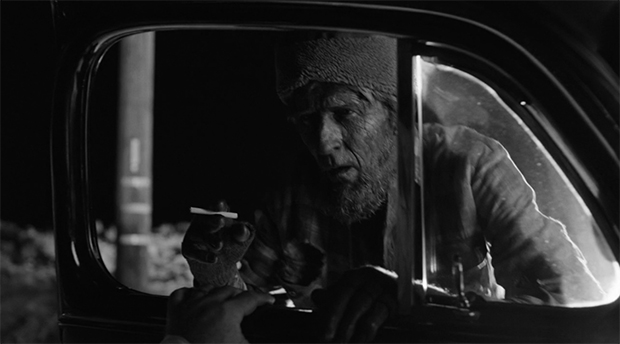
Gotta light
It is directly after the girl found the Lincoln penny that we have the "Got a light?" woodsman, played by an Abe Lincoln impersonator (Abe Lincoln was also famed as a woodsman). So the girl's finding the Abe Lincoln penny connects to the appearance of the "Got a light?" woodsman, as likely does the swinging light at the gas station.
And of course the Lincoln penny connects back to all of Lynch's other Lincolns, such as the Lincoln street in Blue Velvet where Dorothy lives in her alternate reality.
Back to the boy and girl who are now walking down a lonely road past some sort of utility shack connected to power lines. She hesitantly asks, "You live in town, don't you?" The boy replies yes, and she says, more confidently, "You live by the school." He asks her, "How did you know that?" and she replies, "I just do. So, I thought you were going with Mary." The boy tells her, "No, no, that's over." She asks, "Are you sad about that?" He says no. Not seeming to quite know if she believes him, the girl replies, "Oh, okay, that's good, that's good, that's good."
She tells him, "It was really nice if you to walk me home." And he tells her, "I really wanted to. Do you mind if I give you a kiss?" At first she demures. "I don't know, I'm just..." He asks, please, for just one. She consents. He gives a soft peck on the side of her mouth. Flustered, excited, she draws away. They say good night to each other. She ascends the stairs to her porch and goes in the house after a pause to look back at him. He is smiling, pleased.
This conversation is a replay of one that Jeffrey and Sandy have after just meeting in Blue Velvet. She has stepped out of the dark of night, a vision to ask if he is the one who found the ear. She then asks him if he went to Central High School. When Jeffrey asks her how she knows, she replies, "I just know, that's all", saying then she says she remembers him from the high school. At first we are given the impression, with Jeffrey wondering how she knew, that she might be interpreting this as being a kind of psychic aptitude, but she says she remembers him from school, and she also excuses herself as knowing things because her bedroom is above her father's office, so she hears things. She then leads him to Lincoln street, the place where danger is. We have the same combination here, the Lincoln penny, and then the girl seeming to show, as far as the boy is concerned, a kind of psychic aptitude with her knowing about where he goes to school and he lives. She also refuses to answer how she knows. But then one also guesses she does know a good bit about him because she then asks about Mary.
I had spoken again of the faithful/faithless theme in respect of Dido. Sandy was in a relationship when she met Jeffrey and they danced around this a bit before she and Mike finally broke up and she got together with Jeffrey--but then Sandy endured the shock of finding out Jeffrey was having sex with Dorothy. This girl is concerned about Mary as the boy had been going with her, and she is checking out what's up with him if he is walking her home. She's assured the relationship with Mary is over.
Back to the Abe Lincoln look-alike woodsman who had descended into the desert. Wandering through the dark desert again, he finds his way to a radio station. KPJK. The Platters' "My Prayer" is playing.
Was this, by any chance, the song that the boy and girl had heard?
When the twilight is gone and no songbirds are singing
When the twilight is gone you come into my heart
And here in my heart you will stay while I pray
My prayer is to linger with you
At the end of the day in a dream that's divine
My prayer is a rapture in blue
With the world far away and your lips close to mine
Tonight while our hearts are aglow
Oh tell me the words that I'm longing to know
My prayer and the answer you give
May they still be the same for as long as we live
That you'll always be there at the end of my prayer
The song debuted on July 7 1956 and was a #1 best seller in stores by August 4, 1956, the flip side being "Heaven on Earth". August 18 through September 1 it was most played by Disk Jockeys. During this time it was most played in jukeboxes. On August 18 it hit #1.
One of the singers in The Platters was a man named David Lynch.
While "My Prayer" was rising on the charts, on July 30, 1956, Dwight Eisenhower signed a resolution that declared "In God We Trust" would be on all currency.
We see the ON AIR sign in the station above the DJ's log, and the PROMO platter spinning. A thunderbolt, like Dr. Amp's, is also on the platter. In the center of the 45 is an insert that fits it to the 33 and 1/3 table. It is a triskelion.
"My prayer" came out on Mercury, the artists being Georges Boulanger and Jimmy Kennedy, vocals by the Platters.
Kennedy enters again.
I've discussed this triskelion a couple times now, in relationship to the puzzle of the congressman's dilemma, the woman in the bikini, and how it all relates to Trinity and the bomb.
We see on the clock it's 10:15.
We have shots of a mechanic and a waitress listening to the station, as well as the girl who is now dressed in her pajamas and in her bedroom.
The girl has curious dark bruises on the right side of each knee. What has caused these? Was she for some reason in leg braces and these caused the bruises?
The woodsman enters the station, a woman at a file cabinet turning and seeing him, the feel much like out of an Edward Hopper painting. He asks, "Got a light? Got a light?" He crushes her skull. Next he enters the DJ's booth, asks twice, "Got a light? Got a light?" and proceeds to crush his skull without receiving an answer.
Static goes out over the radio as he swipes the needle off the record. We see the girl is listening on an old Silvertone 1, sold by Sears and Roebuck from 1949 to 1951.
The woodsman speaks over the microphone, his words replacing the recording to which all have been listening, "This is the water, and this is the well. Drink full and descend. The horse is the white of the eyes and dark within."
"My Prayer" had the original title of "Avant de Mourir" (Before Dying).
As the woodsman speaks, the woman at the diner falls into a deep sudden sleep.
As does the mechanic. We feel perhaps a sense of relationship of the mechanic with Ed, and the waitress at POP'S diner with Norma, especially as these are the only two professions figured and are paired. One is a little reminded of Sleeping Beauty, their love story in a state of years-long suspension.
The girl stretches out and goes to sleep.
The frog-bug from the egg in the desert climbs into the girl's room through her open window. As it climbs upon her bed, we see it has a long proboscis, like the Jumping Man's mask, and the robber fly.
The sleeping girl opens her mouth. The frog-bug doesn't pry open her mouth. The girl opens her mouth. And the bug crawls in. She closes her mouth and swallows.
A jockey rides a horse. Here we have a disk jockey. Walter Winchell coined the term in 1935, a jockey being an operator of a machine.
The woodsman finishes his repeating of the incantation, and also finishes crushing the top of the DJ's skull. He leaves the station, walking out into the dark night to a flash of lightning. In the distance we hear a horse whinnying.
The show closes on the girl sleeping to the static of the radio.
ON THE ATOMIC AGE AND TWIN PEAKS
Now to move beyond the above into a different vein of analysis. Lynch is older than me, but we have some parallels as far as having grown up in the Pacific Northwest during the cold war, with scientists for fathers, mine having been a young research scientist at Hanford in the late 1950s and through the 1960s. Lynch's family also moved out of the Pacific Northwest to the south, as did mine in the late 1960. Lynch was in Boise, Idaho, Spokane, Washington, and Alexandria, Virginia while I was in Seattle, Richland, Washington and then in Augusta, Georgia. So we also shared that same move from the Pacific Northwest to the east.
Spokane is a very green place north of Richland, but it is only around 30 minutes out of Spokane that one starts hitting the steppes area, which becomes desert at Hanford. Certainly, as a child in Spokane, Lynch was aware of Hanford about three hours to the south.
Hanford was born of WWII, part of the Manhattan Project, and was where the plutonium for Nagasaki was manufactured). Because of my experiences in Richland, growing up in the desert near Hanford, the town's focus being on the bomb, it was born for the bomb, and my father having done radiation research, a great preoccupation with "the bomb" has been a part of my history.
Lynch was born in January of 1946, half a year after Trinity. The inception of the atomic age was one of public excitement and fear. It didn't take long for the conflagrations of the atomic era to filter through the subconscious into sci fi fiction/films such as Them, which came out in 1954, the same year as Godzilla. Whereas Godzilla was awakened and rose from the ocean to trample on Japan, in Them radiation spawned giant ants that fed on people. They moved from the desert area into metropolitan LA. I'd seen the film on television by the time I was seven, and I would lie in bed at night wondering about what was going on out in that dark desert, up in the Horse Heaven Hills. Though I was assured giant ants wouldn't happen, the prospect of something terrible still seemed to loom out there. The desert was a wonderful place, and yet there was this darkness that was the reality of radiation contamination, which was and had been happening at Hanford and would make it into what is now the most toxic site in the western hemisphere and a superfund clean-up site.
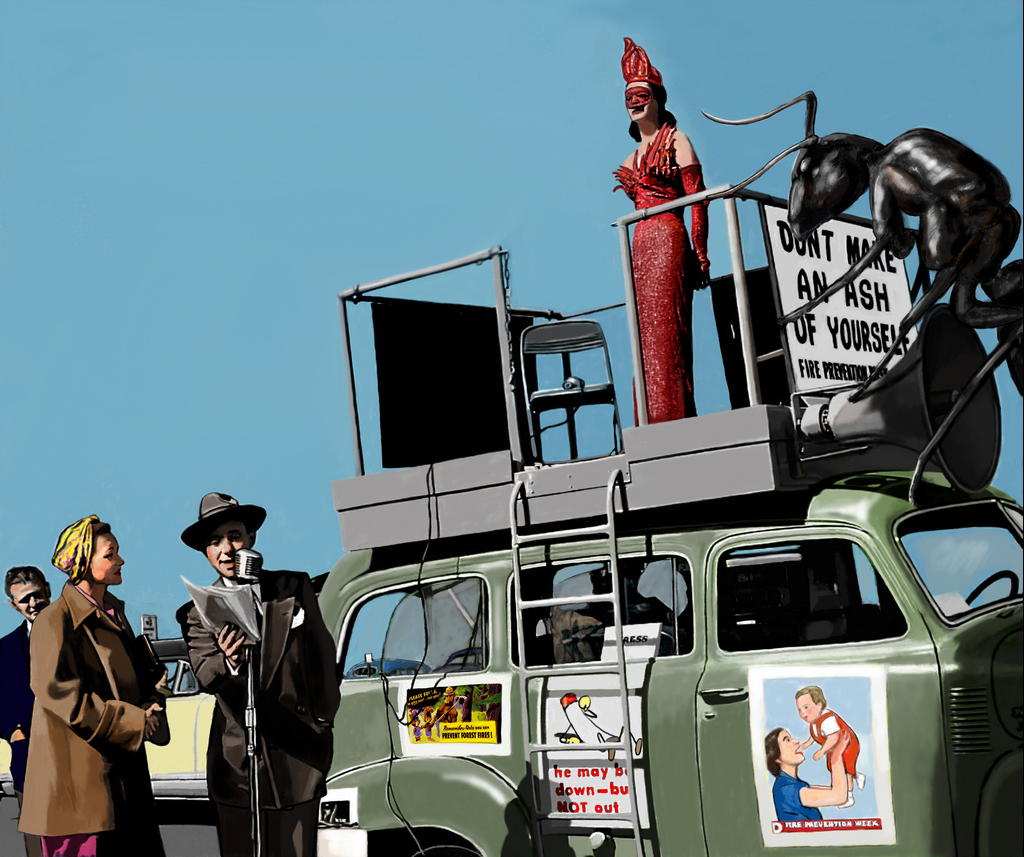
2006, Fire Prevention Week Meets "Them", digital painting based on
Richland photo from the Hanford Declassified Project archive.
Got a light? Lynch's "Got a light" speaks to something different, but it still reminds me that at Hanford and Richland, fire prevention was of paramount concern, considering the plutonium manufacturing facility and all that radioactive material. If an out-of-control brush fire hit Hanford it would have been a radiation contamination disaster. Richland had its fire prevention drives, the horrors of past and prospective futures made comfortably consumable with community celebrations and parades and a glamorous fire prevention queen named Miss Flame. Children adorned their bikes with crepe streamers and participated in fire prevention bike parades. In their skeleton and devil masks they mingled with clowns in Halloween style frivolity, pulling little red wagons in which baby dolls spilled out the windows of burning houses. Congratulations were handed out--first, second and third place ribbons. Fun and games for a day, but anxiety followed children trained to be hyper responsible guardians looking out for parents and adults who would carelessly let a cigarette ash fly loose in the desert wind. In school, we were told to be especially alert around adults drinking alcohol. I remember being seven and nearly beside myself, one of those little guardians, sitting outside on summer evenings as adults drank and smoked, red embers flickering away on the breeze. "It's all right," they'd say. But the combination of cigarette ash, a pleasant desert night breeze, and a little alcohol spelled death to me.
I smoke a few no-more-than-this cigarettes a day, always outside a social context, away from my writing, away from others. A couple of isolated drags at a time. I only relate this information because there's an essential point. After watching episode eight of Twin Peaks: The Return, I was sitting with my husband on the screened-in porch of our apartment and I said I was going into the kitchen for a couple of those daily allotted drags. My husband asked me why I didn't go ahead and smoke outside, why I would go into the kitchen instead. Indeed, I am and always have been uncomfortable with smoking outside. "The breeze," I said, and then I realized, it was still that fear of the stray burning ember and a breeze. It is so engrained that smoking outside is uncomfortable, anxiety-provoking. Even in a screened-in porch.
in the 60s, living near Hanford, I went to sleep worrying about those insects out in the desert, like the ants in Them, and what radiation might be breeding out in the Horse Heaven Hills. Nothing in the desert near these Manhattan Project sites was innocent any longer. One wondered what invisible malevolence was carried in the dust storms from which there was no escape, particulants slipping past windows and doors. One wondered what contaminants were traveling along with the tumblin' tumbleweeds that blew out of the desert and down the roads.
The 8th part of Twin Peaks: The Return was very familiar territory to me in many ways.

2009, The Fire Prevention Parade, digital painting based on
Richland photo from the Hanford Declassified Project archive.
And every day at school I would stare out the windows, ever anticipating the bomb that might be dropped on us, its huge fiery cloud that would be the end of our corner of the world.
We made a trip down highway 380 about 2008, and were hoping to visit the Trinity Monument site, but ended up getting there too late to do anything but to pause for a few moments at where the turn off to the monument was. Which was all right, I suppose. We had a lot of miles to cover that day and for hours had been aware that we wouldn't get there in time to do anything but have a passing glacne.
As it turned out, at night, on that very empty stretch of road, the atmosphere and smells were much like I had experienced growing up near Hanford. A car's headlights are no match for a moonless desert and within a few feet the black becomes a wall. In 1945, the citizenry in these areas had no idea what was being manufactured in the desert wilderness, which would soon make news at Hiroshima and Nagasaki and thereafter rule their world with the threat of a man-made apocalypse devastating their mid-century modern world at any moment.
I had experienced the same geographical deja vu the first time I visited Roswell, New Mexico, on the same highway, coming up over a hill and seeing the lights of Roswell in the distance, at twilight, the smells the same as Richland in the 60s, the exact same feel of the desert, the same haze. Which is odd to me as I have been in many areas of the desert southwest--in northern and southern Arizona and New Mexico, in Utah, in Texas--and thus far it is only certain sections of highway 380 through New Mexico where I feel as if I have stepped back to 1960s Richland and Hanford.
People now often look back on post WWII, mid-century modern artifacts as emblematic of simpler, hope-filled, optimistic times and don't comprehend the very thin skin over an abyss of dread and the desperate need for controls that projected a sense of normalcy. And it is this place that provides a good deal of fodder for Lynch's "surrealism", the retroactive psychic violence embedded in the split of the atom that erupted in the nuclear-chain-reaction power of Trinity.
STAB AT A TIMELINE
A timeline as best as can be reasoned on information given thus far:
PART ONE:
1. Supernatural - B&W room
2. Jacoby's trailer, day - Wednesday
3. New York, Sam and Tracey, after 10 at night - Wednesday
4. The Great Northern Lodge, Ben and Jerry, day - Thursday
5. Twin Peaks Sheriff's Department, Lucy and the insurance agent, day - Thursday
6. Buella's, night - Thursday
7. New York, 2nd night (we know this is certain) - Thursday
8. Buckhorn, South Dakota, discovery of Ruth, day - Friday
9. Twin Peaks, Margaret calls Hawk at work, night - Friday
10. Buckhorn, the coroner's, day - Saturday
11. Buckhorn, Hastings taken into custody, day - Saturday
12. Twin Peaks, Hawk, Lucy and Andy in the conference room, day - Saturday. (Lucy wears the same clothes as in the scene with the insurance salesman, but this scene and that one are separated by at least one night in Twin Peaks. Hawk spoken with Margaret at night, at the office, but this scene is in daylight and so is another day.)
13. Buckhorn, Hastings interrogated. We have the initial Thursday to Saturday timeline from this. - Saturday
14. Buckhorn, Hastings home searched - Saturday
15. Supernatural - B&W room.
PART TWO
1. Buckhorn, Phyllis visits Bill in jail -- Saturday (Bill was picked up on Saturday, presumably)
2. Buckhorn, Mr. C kills Phyllis -- Saturday night
3. Las Vegas, Duncan and Roger in Las Vegas, a woman is given a job -- Saturday night
4. Buckhorn, Darya, Ray, Jack and Mr. C eat at the motel's diner -- Saturday night
5. Twin Peaks, Hawk visits Glastonbury Grove - Saturday night
6. Laura disappears from the Red Room -- Undetermined time but perhaps equivalent to Saturday night in real time
7. Buckhorn, Jack and Mr. C hide the Mercedes, Ray lands in prison -- Sunday
8. Buckhorn, Jack and Darya killed by Mr. C -- Sunday
9. Supernatural, Cooper looks out on Mr. C driving the car -- Monday (as for as Mr. C goes)
10. New York, Cooper drops into the New York box -- Fall back to NY Thursday
11. Twin Peaks, Sarah Palmer watches television -- Undetermined time, can't be stated with any confidence right now due to Cooper's slipping into Thursday and then being swept out into space again. Perhaps Thursday.
12. Twin Peaks, Shelly and James are seen at The Bang Bang -- Undetermined time, can't be stated with any confidence right now due to Cooper's slipping into Thursday and then being swept out into space again. Perhaps Thursday.
PART THREE
1. Cooper falls through space, spends time with Naida and American Girl, then takes Dougie's place. The American Girl's watch seems to read Saturday the first. Frost's The Secret History of Twin Peaks is based on a dossier of events relevant to Twin Peaks that is being researched by Tammy Preston in August of 2016, and which is finally determined to have been put together by Major Briggs. Saturday falls on a 1st on 2/1/2014, 3/1/2014, 11/1/2014, 8/1/2015 and 10/1/2016. If this is 2016 then this Saturday the 1st that was on the American Girl's watch would likely have to be October 1st of 2016--but in the otherworldly space who's to say what year it is? SA could instead refer to Saturn (and perhaps does as well). If the date is Saturday the first, we still have Mr. C driving down the highway on, according to prior events, what should/could be a Monday. Right now we would take it for granted that Dougie is replaced by Cooper during the same time frame, on Monday, though it may be Saturday, October the 1st in this room with the American Girl. - Monday, as well as Saturday October 1st
2. Buckhorn, Mr. C found on the highway - Monday
3. Twin Peaks Sheriff's Dept bunnies. Perhaps this is Monday. - Monday
4. Twin Peaks, Jacoby's shovels. Also perhaps Monday. - Monday
5. Las Vegas, Back to Vegas and the Silver Mustang Casino, this occurring on the same day that Cooper replaces Dougie. - Monday
6. Philadelphia, The FBI meeting at sunset. Phillie timeline appears to link right in with Buckhorn/SD - Monday
7. Twin Peaks, The band at the Roadhouse would be a night scene. Just based on all previous shots in this episode being during the day, I will go with this being Monday night. - Monday
PART FOUR
1. Las Vegas, The house with the red door. If it was Monday when Cooper returned as Cooper-Dougie, it is still Monday as he is still at the casino. He goes to the Jones household on Monday night. - Monday
2. Philadelphia, The meeting of Gordon with Denise over taking Tammy to South Dakota would be Monday night as Gordon had earlier said they would be in South Dakota the next morning. - Monday
3. Twin Peaks, Frank Truman's return to the Twin Peaks Sheriff's Department fits with possibly being Monday night as Maggie tells him about an incident, seemingly that day, of a boy overdosing in class, a school day. - Monday
4. Las Vegas, Tricked. Las Vegas morning at the Jones household. This would be the following morning. - Tuesday
5. Buckhorn. Access denied. A seeming wrench is thrown in. It looks like night at Buckhorn in Constance's office with the news that there is a security issue on the prints of the John Doe. But, as I've pointed out, there are many peculiarities about this scene. - Undecided as anomalous
6. South Dakota. Faces of Stone. The ride to the Yankton prison would be Tuesday morning. They are to be there at 9. - Tuesday
7. South Dakota. The meeting with Cooper's doppelganger. This is approximately at 9 on Tuesday morning. Another wrench is thrown into the timeline with the date, perhaps, of Cooper being picked up given as 9/22. 9/22 in 2016 is on a Thursday. 9/22 in 2015 is on a Tuesday. 9/22 in 2014 does fall on a Monday, so that would fit if we were moving 25 years forward from the Twin Peaks events of February 1989 (aired in 1991), but The Secret History of Twin Peaks has Briggs' dossier being research in 2016 and the comments made wile it is being researched don't indicate any knowledge on Cooper or Briggs past when the original series ended so it seems it would be researched before the events in the Return. Cooper's birthdate on his prison information is also wrong, off by nineteen years. - Tuesday (I'm sticking with Tuesday for now, based on the Thursday death of Ruth)
8. South Dakota. The blue night scene in which Gordon and Albert discuss Cooper and the Blue Rose cases. I think it's not night, that it is instead blue because of Blue Rose. - Tuesday.
PART FIVE
This is not chronological. All scenes appear to have happened on Tuesday, we having returned to Tuesday dawn at the beginning of this part. The idea of altering your reality was raised at the beginning of this part with the neon Las Vegas sign for the David Copperfield show. I am led to question what happened here that is a revision of Tuesday in Part Four. This may not just be filling in with information for Tuesday that wasn't covered in Part Four. We may have something that has occurred that altered reality.
1. Las Vegas - Lorraine and the hit men. Argent.
2. Device in unknown place, called by Lorraine.
3. Buckhorn. Coroner, Dave and Dan. The ring to Dougie from Janey-E. About 7:00 a.m. by clock.
4. South Dakota. Mr. C in prison, sees Bob within. Morning.
5. Twin Peaks. Mike rejects Steve's application.
6. Twin Peaks. Doris and Frank. Leak and car problem. (Car was checked two hours before which may or may not be too late for early morning.)
7. Las Vegas. Janey prepares Sonny Jim and Dougie for drive to school and work.
8. Las Vegas. The hit men go past Rancho Rosa house.
9. Las Vegas. Lucky 7. Dougie arrives at work at 8:55 a.m. Calls Tony a liar. Meeting with Bushnell.
10. Las Vegas. Mitchum brothers fire Burns and put Warrick in his place.
11. Las Vegas. Rancho Rosa. Car explosion.
12. Las Vegas. Jade mails key.
13. Twin Peaks. Shelly gives Becky money. Becky gives Steven money. Earlier he was looking for work.
14. Las Vegas. 5:30 p.m. Dougie leaves work.
15. Twin Peaks. Night. Andy and Hawk research files.
16. Twin Peaks. Jacoby's internet show at 7:00 p.m. Jerry in woods. See Nadine.
17. Alexandria, Virginia. Military gets ping on Briggs. Cindy will fly out immediately to South Dakota.
18. Twin Peaks. Richard at roadhouse chokes woman.
19. Philadelphia. Back in Phillie, Tammy researches the seemingly reversed print.
20. South Dakota. Mr. C takes control of prison with cow jumped over the moon.
21. Buenos Aries, Argentina. Seeming morning scene. But seems possibly the same morning as when device was shown at the beginning of this Part, though what happens with the device is different after the red dots flash. So another wrench..
PART SIX
1. Las Vegas. Carry over from Part Five. Cooper-Dougie still stands before the statue. He is taken home. Janey gets an envelope with photo of Dougie and Jade from a different day. She arranges to pay the loan sharks the next day. Cooper-Dougie goes through the files for Bushnell. Still Tuesday.
2. Philadelphia. Albert finds Diane. Possibly Tuesday night.
3. Twin Peaks. Meeting between Richard Horne and Red.
4. Twin Peaks. The New Fat Trout Trailer Park.
5. Twin Peaks. Miriam at the Double R.
6. Twin Peaks. Richard Horne hits the boy. 3-6 are all one event stream.
7. Las Vegas. Duncan gets red message, pulls file for Ike.
8. Las Vegas. Rancho Rosa. Cleaning up explosion scene likely from day before, Tuesday, so this would be Wednesday. Time glitch. the 1-1-9 woman is back to Monday.
9. Las Vegas. Ike the Spike gets the envelope with the hit on Lorraine and Dougie.
10. Las Vegas. Wednesday. Cooper-Dougie gives Bushnell the files that implicate Tony.
11. Las Vegas. Janey meets loan sharks at park as arranged day beforehand. Wednesday.
12. Las Vegas. Ike the Spike kills Lorraine.
13. Twin Peaks. Richard Horne cleans blood off the truck.
14. Twin Peaks. Hawk finds Laura's missing pages.
15. Twin Peaks. Doris and Frank argue again about the car. We learn their son committed suicide.
16. Bang Bang.
PART SEVEN
1. Twin Peaks. Jerry missing in the woods. We last saw him possibly Tuesday night watching Jacoby's show in Part Five.
2. Twin Peaks. Hawk gives Frank the missing pages. Still Wednesday it seems.
3. Twin Peaks. Andy goes to speak with man whose truck hit the child. Still Wednesday it seems, or at least the Richard Horne timeline.
4. Twin Peaks. Frank speaks with Doc Hayward.
5. Buckhorn. Cindy shows up and finds they have Briggs' body. Would be Wednesday.
6. Philadelphia. Gordon and Albert go to speak to Diane.
7. Gordon, Albert, Diane and Tammy fly to South Dakota.
8. South Dakota. Diane sees doppelcoop. Wednesday (still going by Part One).
9. Twin Peaks. Andy waits to speak to owner of truck who does not show. Possible wrench? Andy's watch reads it's the 10th. 5:05.
10. South Dakota. Doppelcoop arranges for his escape with the warden for that night, same night as seeing Diane.
11. Las Vegas. Cooper-Dougie interviewed by police over the explosion of his car. Would be Wednesday still for them.
12. Las Vegas. Ike the Spike attacks Cooper-Dougie. Evening to night.
13. Twin Peaks. Beverly and Ben look for source of noise that began sometime the prior week.
14. Twin Peaks. Beverly goes home to her husband. Night.
15. Twin Peaks. The sweeping scene. Night.
16. South Dakota. Cooper released at 1:00 a.m. on Thursday.
17. Twin Peaks. Time glitch. 1:00 a.m. in South Dakota but still dinner hour in Twin Peaks at the Double R. Bing looks for Billy. Have we simply dropped back in time to earlier Wednesday night?
PART EIGHT
Part Eight begins with Thursday about 1:00 a.m. in South Dakota and then goes back to July 16, 1945 and the Trinity bomb. It then moves forward to August 5, 1956.
Approx 16,300 words or 33 single-spaced pages. A 125 minute read at 130 wpm.
Return to the top of the page.
Prior: Go to Part 7
Next: Go to Part 9
Go to Table of Contents for Analysis of Twin Peaks Return
Link to the main TOC page for all the analyses



